#the conflict coming from cruz fully being into this
Text










Special Ops: Lioness - 1x07
#specialopslionessedit#special ops lioness#special ops: lioness#aaliyah amrohi#cruz manuelos#stephanie nur#laysla de oliveira#special ops lioness 1x07#special ops lioness spoilers#aaliyah x cruz#femslash related stuff#muslim lgbt#god this ep was kind of perfect for what you'd expect at this stage of a spy/target story?#wow#it was hot it was heartbreaking#the conflict coming from cruz fully being into this#the dressing room scene and then them arriving here so single-minded#cruz scoping out the rooms and already taking her shoes off#aaliyah trying to be more patient but as soon as that door clicks the way she swings around#it's funny and sweet and sexy but so temporary :(
1K notes
·
View notes
Text
The 30 Best GBA Games (Game Boy Advance) of All Time 2021
The 30 Best GBA Games (Game Boy Advance) of All Time 2021
1. The Legend of Zelda: The Minish Cap
The Icon of Zelda: The Minish Cover shirts our checklist for a variety of motives: Never-ending allure, fantastic overworld and dungeon layout, clever puzzles as well as wiser challenge aspects. The Minish Cap told the backstory of Vaati, the leading antagonist and important shape in A number of Swords. Right after Vaati petrified Princess Zelda, Hyperlink rescued a wonder sentient head wear using a bird go that, when donned, lets him get smaller into a minute dimensions just like the{Buzrush.com} Minish, the small beings who have did the trick tirelessly to aid take out darkness coming from the planet. The head wear, the game’s central quirk, was designed exploring Hyrule a lot differently than before. It opened up new locations and available new viewpoints, illuminating just how stunning the field of Hyrule actually is. The Minish Limit obtained all the prominent features of a successful Zelda online game, from excellent dungeons to whimsical townspeople for the absolute satisfaction given when launching a jewel chest. And were you aware The Minish Cap was designed by Capcom, not Nintendo? It remains to be one of the better Zelda video games of all time.
2. Golden Sunshine
Camelot Application Organizing, known for Glowing Power and Mario athletics titles, shocked every person with 2001’s Wonderful Direct sunlight, a valiant attempt at providing a unique Final Fantasy-style encounter to your hand-held foundation. And the child performed Camelot at any time to be successful. Wonderful Sunlight starred Isaac and a few other adventurers inside their quest to save the concept {Buzrush.com}of Weyard. It possessed most of the trappings of an Ultimate Fantasy online game - a help save-the-world storyline, random convert-structured battles, and summons - but it also had a good variety of overworld puzzles and much more intense tale owing to a great deal of exposition and dialogue. Its sequel, Wonderful Sunshine: The Shed Grow older, shared the tale with the perspective of the antagonists. The original is not only the best GBA RPG ever; it’s one of the best turn-based RPGs released to this day, even though both games are excellent in their own right. If you missed out on Golden Sun, find a way to play it, such as through the Wii U. A sequel called Gold Direct sunlight: If you want even more Golden Sun in your life, Dark Dawn also came to DS, as well.
3. Castlevania: Aria of Sorrow
The final and third GBA Castlevania video game, Aria of Sorrow, revealed that it had been possible for the collection to attain the level of effectiveness displayed in Symphony in the Nights. That is ideal. First, we said Metroid Fusion was better than Super Metroid, and now we’re putting Aria of Sorrow on the same pedestal{Buzrush.com} as Symphony of the Night. In contrast to its predecessors, Aria of Sorrow got the vampiric sequence into the long term, setting customers within the boots of Soma Cruz, a teen with occult energy who could produce the reincarnation of Dracula. Aria of Sorrow has got the low-linear research of SotN, meaningful RPG mechanics, a handful of great weapons, and a series of daunting but incredible boss struggles. Throw in the Strategic Souls technician, which adjusts gameplay and data by beating foes, and Aria of Sorrow was the richest entrance in the collection currently. It holds right now as one of the greatest Castlevania games, and for a flavor of a related design activity, try Bloodstained: Routine of your Nighttime on Change.
4. Metroid Fusion
It’s no great surprise Metroid Fusion was developed via the similar team that manufactured Extremely Metroid. Fusion almost looked like an not related sequel if this started in 2002. Combination showcased in a similar fashion extended {Buzrush.com}open-society to learn, allowing gamers to review and reveal ways and secrets ahead at their own speed. The team at Nintendo R&D1 highly processed the fight from Awesome Metroid and released several new power-mechanics and ups at the same time. Metroid Fusion is not just one of the best games on GBA; it’s the best 2D Metroid ever made, even though it may be blasphemous to say.
5. The Story of Zelda: A Web Link to the Earlier and A number of Swords
Not much has to be stated regarding a Url to the Past, the common top notch-lower Zelda trip for the SNES. The GBA dock helped bring the mesmerizing Dark and Light Worlds of Hyrule to hand-held correctly. The port also introduced a new element, however, named A number of Swords. This supportive mode allows a 2 to 4{Buzrush.com} player workforce to approximately get rid of puzzles and defeat baddies in dungeons. However the primary strategy is exactly what eventually earns The Link to the Earlier an increased identity within this collection, adding A number of Swords created the GBA version the definitive solution to enjoy one of the greatest games ever, even when compared to Nintendo Change On the internet type available by using a subscription.
6. Upfront Wars
Smart Techniques, the recording studio behind Fire Emblem, have also been powering the greatest transform-based method video game on GBA: Advance Wars. The idea was simple: A glowing blue army face looked out against a reddish army, every single one composed of tanks, infantrymen, and artillery. Boasting difficult proper gameplay, a deep promotion, as well as a chart creator, Progress Competitions got all the things a technique enthusiast could want. Like Fireplace Logo, Advance Conflicts originated from{Buzrush.com} a Japanese exceptional collection named Famicom Conflicts, so we are rather lucky to get it in Canada And America. The GBA also got a sequel in Advance Competitions 2: Black colored Pit Escalating. Whilst great, it observed more like add more-on information due to the actually powerful forerunner, as well as the DS sequels weren’t as vintage since the initial. For your similar practical experience, look at Wargroove on Nintendo Swap.
7. Metroid: Zero Goal
Exactly what do you get if you mix the atmosphere and nostalgia in the authentic Metroid with current mechanics? Properly, a darn great sport. Metroid: No Vision, a reimagining of your 1986 classic, retold the storyline of Samus Aran’s initial venture together with the enhanced fight evident in Super Metroid and Metroid Fusion. {Buzrush.com}Beautiful to view and even far better to engage in, Zero Objective manufactured going back to World Zebes feels fully unique again.
8. WarioWare: Twisted!
Established from the frantic “microgame” formula of WarioWare, Inc.: Mega Microgames! , WarioWare: Twisted! included drive comments - certainly one of only two GBA game titles to possess the feature - and also a gyro sensing unit. The outcome? An event unlike another for the hand held. Microgames are necessary competitors to complete speedy-flame activities within minutes. None of the games were particularly complex, but all of them were entertaining. Also the plan, which associated Wario getting{Buzrush.com}mad with a game on GBA and flinging the handheld at the wall structure, fell completely in line with the game’s irreverent development. If you played it in public, ferociously twisting and turning your GBA like a madman, on a scale of sheer “fun value,” you’d be hard-pressed to find a more satisfying GBA game, especially. Some of the games can also be found in the 3DS generate WarioWare Yellow gold, in conjunction with microgames from the other collection.
9. Mario & Luigi: Superstar Saga
Mario & Luigi: Superstar Saga kicked off of one among Nintendo’s best Mario games and spin off selection. Despite the fact that starting off within the familiarized Mushroom Empire, the video game speedily transitions to Beanbean Kingdom, a substantial world how the bros should traverse to recover Princess Peach’s speech. Split{Buzrush.com} up to the core concept, Superstar Saga had been a flip-dependent part-playing activity. But Nintendo and today-defunct programmer AlphaDream layered the combat by adding timing-structured maneuvers that nodded to Mario’s platforming origins. Controlling Mario and Luigi all at once also contributed to the game’s many fun spot puzzles. Superstar Saga stands apart today as the GBA’s ideal RPGs.
10. Closing Imagination VI
Closing Fantasy VI did not arrive at Game Child Upfront in America till 2007, greater than two year period after the Nintendo DS started. Often, it is introduced like a “thank you” to Activity Boy followers for his or her lengthy-standing help and support. Final Fantasy VI was a pitch-perfect port that brought the epic story, strategic {Buzrush.com}gameplay, and wondrous soundtrack to a handheld device for the first time, as one of the best entries in the long-running role-playing series. Final Fantasy VI rightfully earns a spot on our list, even though the GBA also received great ports of Final Fantasy I & II, Final Fantasy IV, and Final Fantasy V. It is merely the most effective RPGs ever produced and one of many top Closing Imagination game titles in recent history.
More Info-
https://www.buzrush.com/the-30-best-gba-games-game-boy-advance-of-all-time-2021/
https://sites.google.com/view/best-gba-games/home
142 notes
·
View notes
Text
Monday, October 25, 2021
Vaccine mandates create conflict with defiant workers
(AP) Josh “Chevy” Chevalier is a third-generation shipbuilder who hasn’t missed a day of work during the pandemic in his job as a welder constructing Navy warships on the Maine coast. But he’s ready to walk away from his job because of an impending mandate from President Joe Biden that federal contractors and all U.S. businesses with 100 or more workers be fully vaccinated against COVID-19. “People are fighting for their constitutional rights—the way they think their life should be,” said Chevalier, one of hundreds of employees at Bath Iron Works threatening to leave. Chevalier is among a small but significant number of American workers deciding whether to quit their jobs and careers in defiance of what they consider intrusive edicts that affect their freedoms. The refusers come from all types of occupations—defense industry workers, police officers, firefighters, educators and health care workers. In Seattle, a group of city firefighters turned in their boots at City Hall on Tuesday to protest a vaccination requirement. Thousands of people have sought religious or medical exemptions that were rejected; others won’t stand to be told what to do and have quit or been fired.
Powerful storm brings heavy rain, flooding and mud flows to Northern California
(AP) A powerful storm barreled toward Southern California after flooding highways, toppling trees and causing mud flows in areas burned bare by recent fires across the northern part of the state. The National Weather Service's Sacramento office warned of "potentially historic rain." Flooding was reported across the San Francisco Bay Area, closing streets in Berkeley, inundating Oakland's Bay Bridge toll plaza and overflowing rivers in Napa and Sonoma counties. Power poles were downed and tens of thousands of people in the North Bay were without electricity. South of San Francisco, evacuation orders were in effect in the Santa Cruz Mountains over concerns that several inches of rain could trigger debris flows in the CZU Lightning Complex Fire burn scar. Further south, parts of western Santa Barbara County saw evacuation warnings upgraded to orders in the area burned by this month's Alisal Fire. Strong winds were also expected, with gusts of up to 60 mph at the windiest spots in Northern California. Elevations above 9,000 feet in the Sierra Nevada could get 18 inches of snow or more from Sunday until Monday morning.
Colombia’s most wanted drug lord captured in jungle raid
(AP) Colombian security forces have captured the country’s most wanted drug trafficker, a rural warlord who stayed on the run for more than a decade by corrupting state officials and aligning himself with combatants on the left and right. President Iván Duque likened the arrest Saturday of Dairo Antonio Úsuga to the capture three decades ago of Pablo Escobar. Úsuga, better known by his alias Otoniel, is the alleged head of the much-feared Gulf Clan, whose army of assassins has terrorized much of northern Colombia to gain control of major cocaine smuggling routes through thick jungles north to Central America and onto the U.S. He’s long been a fixture on the U.S. Drug Enforcement Administration’s most-wanted fugitives list. Authorities said intelligence provided by the U.S. and U.K. led more than 500 soldiers and members of Colombia’s special forces to Úsuga’s jungle hideout, which was protected by eight rings of security.
Rise in ‘needle spiking’ puts women in Britain on high alert
(Washington Post) Britain is increasingly feeling like a hostile place for women. There have been multiple reports of “needle spiking”—which involves an injection being administered to someone without their knowledge or consent, usually in a nightclub or bar setting—as opposed to the more commonly known method of contaminating alcoholic drinks. Zara Owen, a 19-year-old student in Nottingham, central England, said she woke up after clubbing with a “sharp, agonizing pain in my leg” and “almost zero recollection” of the night before. She walked with a limp for the remainder of the day, she wrote on social media, before finding a “pinprick” and realizing that she had been “spiked” by a needle that had pierced through her jeans. Thankfully her friends helped her return home safely. The reported needle-spiking incidents come after two high-profile murders of women on the streets, which have left Britain stunned. The overall number of reported needle-spiking incidents remains far below the number of drink-spiking incidents thought to occur, but police are wary.
Austrian chancellor threatens lockdown for unvaccinated
(ABC News) Unvaccinated people in Austria could face new lockdown restrictions if coronavirus case numbers continue to rise, Chancellor Alexander Schallenberg said Friday night. Schallenberg announced that if the number of COVID patients in intensive-care units reaches 500, or 25 percent of the country’s total ICU capacity, entrance into businesses such as restaurants and hotels will be limited to those who are vaccinated or recovered from the virus. If the number reaches 600, or one-third of total ICU capacity, the government plans to impose restrictions on unvaccinated people. In this case, they would only be allowed to leave their homes for specific reasons.
Russia and China hold first joint patrol in the western Pacific, Russian defense ministry says
(CNN) Russian and Chinese warships have conducted the first ever joint patrol in the western part of the Pacific Ocean, the Russian defense ministry said in a statement on Saturday. The patrols involved a total of 10 warships, five from each nation, and lasted a week, from Sunday, October 17 to Saturday, October 23, covering 1,700 nautical miles, according to the Ministry. The two countries have an ongoing military partnership and have conducted a series of joint military drills, the most high profile of which was “Vostok 2018,” which involved a simulated battle in which a Russian-Chinese coalition fought a fictional enemy.
Afghanistan hurtling towards collapse, Sweden and Pakistan say
(Reuters) Afghanistan will shortly collapse into chaos unless the international community acts rapidly, Swedish and Pakistani ministers warned on Saturday. Afghanistan plunged into crisis after the hardline Islamist Taliban movement drove out the Western-backed government in August triggering the abrupt end of billions of dollars in assistance to its aid-dependent economy. “The country is on the brink of collapse and that collapse is coming faster than we thought,” Swedish development minister Per Olsson Fridh told Reuters in Dubai. He said economic freefall could provide an environment for terrorist groups to thrive, but that Sweden would not channel money through the Taliban, instead boosting its humanitarian contributions through Afghan civil society groups. Many countries and multilateral institutions have halted development assistance but increased humanitarian aid since August, reluctant to legitimise the new Taliban rulers.
Strong quake shakes Taiwan, no damage reported
(Reuters) Buildings shook in Taipei on Sunday as an earthquake of magnitude 6.5 struck northeastern Taiwan, but there were no reports of damage. It had a depth of 66.8 km (41.5 miles), and could be felt across the northern, eastern and western parts of Taiwan, with the epicentre in Yilan county, the weather bureau said. Taiwan lies near the junction of two tectonic plates and is prone to earthquakes.
Israeli official says reopening of U.S. Palestinian mission in Jerusalem may not happen
(Reuters) Israel’s deputy foreign minister said on Sunday that the Biden administration may shelve its plan to reopen a U.S. diplomatic mission for Palestinians in Jerusalem after Israel voiced opposition to such a move. The Jerusalem consulate was subsumed into the U.S. Embassy that was moved to the contested city from Tel Aviv in 2018 by the administration of former President Donald Trump—a reversal of U.S. policy hailed by Israel and condemned by Palestinians. U.S. Secretary of State Antony Blinken this month reiterated Washington’s plan to reopen the consulate as part of efforts to repair Palestinian ties. He did not give timelines. “I believe that I have good reason to think this will not happen,” Deputy Foreign Minister Idan Roll told Israel’s Ynet TV.
PM, officials detained, internet down in apparent Sudan coup
(AP) Military forces arrested Sudan’s acting prime minister and senior government officials Monday, disrupted internet access and blocked bridges in the capital Khartoum, the country’s information ministry said, describing the actions as a coup. In response, thousands flooded the streets of Khartoum and its twin city of Omdurman to protest the apparent military takeover. Footage shared online appeared to show protesters blocking streets and setting fire to tires as security forces used tear gas to disperse them. Protesters could be heard chanting, “The people are stronger, stronger” and “Retreat is not an option!” as plumes of smoke from burning tires filled the air. A takeover by the military would be a major setback for Sudan, which has grappled with a stop-and-go transition to democracy since long-time ruler Omar al-Bashir was toppled by mass protests two years ago.
0 notes
Text
Alright, friends and enemies. I’m back with the most recent edition of The Worst Movie on Netflix Right Now™.
Tonight, we’re gonna talk about a little movie called Roped.

I’d love to say that you can learn everything you need to know about this movie from its one-sheet, but naw. I mean, you look up you see a cowboy and a cowgirl kissin’ in the rain. Nothing like a little ranching love, right?
Yeah, no. The premise of this movie is that a rodeo rolls into a small Northern California town where it immediately faces opposition from the animal-rights progressives who don’t want that kind of cruelty-for-entertainment in their town.
The main characters are young rodeo rider Colton, played by legitimate hottie Josh Swickard, and pre-frosh at UC Santa Cruz Tracy, played by....
...Lauren Swickard? Yeah. Looks like the two stars of this little film got married last year. She was originally credited on the production as ‘Lorynn York’, but she’s making a change. And you know, what? Good on you, Lauren. You’re a good looking couple and I wish you both many happy returns.
And now I’m going to insult your very fine work in this here production of Roped.

So Tracy wants to be a lawyer and is entering a 6-year program at UC Santa Cruz to get her law degree fast (Is this even a thing? Never heard of it). But in her last summer in her small hometown (somewhere in Sonoma, I believe), the rodeo has come into town. Only thing is her town councilman dad (played by Casper Van Dien, helllllloooo daddy), is a passionate vegetarian and thinks the rodeo should leave.
That’s it. That’s the conflict. It’s a cheap-ass reverse version of Footloose, where the preacher’s councilman’s daughter just wants to go to the rodeo and eat a damn cheeseburger but her father won’t let her because of his values.
I gotta tell you folks, the biggest problem with this movie is that it’s fucking boring. There is no meaningful conflict here. Yeah, her dad gets mad when he catches her doing various shocking things like sneaking in a half hour past her 12:30 curfew. But Tracy and Colton are both adults and there is nothing stopping them from having a summer fling.
A summer fling that involves nothing more than consensual kissing---but only once Tracy has ended things with her asshole high school boyfriend. He’s careful to make sure not to kiss her before then. Because that would be morally wrong. “Love is worth the risk”? What fucking risk? Everything in this movie is set up to be so perfectly honorable and polite that there’s nothing interesting going on. The stakes are so low, I started to wonder if this was a movie or just a Ken Burns’ documentary about America’s heartland.
But then I remembered. Oh yeah. If this was a documentary, there would be a hell of a lot more Jesus in this movie.
And that’s the thing that just really sucks about Roped. It’s bullshit. It presents a world in which the animal-loving townspeople are so closed-minded they can’t see the beauty and value of the rodeo. They’ve lost touch with the history of the rodeo. And they don’t know rodeo people, because if they did, they would understand how well rodeo people value the animals and how well treated and cared for the animals are.
Now look, I don’t know shit about animal treatment and the rodeo. I’m not wading into that business here. But I have been to two rodeos in the last ten years, including a fairly recent one in Yuma, Arizona. And if there is one thing this movie gets plain wrong is that no one at this fictional rodeo ever talks about Jesus. And that matters.
Consider how a Christian movie review site describes the themes in Roped:
“ROPED has a strong moral worldview where the rodeo cowboys overcome the Romantic, politically correct, progressive, environmentalist worldview of the townspeople led by Tracy’s vegetarian father. The cowboys show the closed-minded progressives how the cowboys actually take care of and love the rodeo animals. The movie also extols family and thankfulness.”
And you know what? That’s an accurate description of the film.
But if the politically correct progressives are the closed-minded ones, does that mean the rodeo cowboys are open and accepting of all peoples? Is that what we’re supposed to take away here?
If so, that’s a fucking fantasy. And a delusional one at best.
I mentioned having been to a rodeo recently, because the one I attended opened with the emcee announcing to the crowd that there are people in this country who want to take away religious freedom and take away their right to worship god, but there at the rodeo, they would never stop worshiping our lord and savior Jesus Christ, and god bless the rodeo and god bless the United States of America. The crowd uproariously applauded.
Now I have no problem with opening an event with an invocation or prayer. It can be a meaningful and thoughtful moment. It can invite all people into a moment of welcoming and thoughtfulness. But it’s quite another to begin an event with a declaration that your right to worship Jesus is under attack, and to equate loving god with being a patriot. As an atheist and a Jewish person who does not accept Jesus into my heart, I felt so uncomfortable, I felt like I should leave.
And that’s the problem with so many of these small town fantasy movies. They present these smalls towns as loving and caring communities. People who look out for each other in a way that people don’t do in the big city. People connected by bonds to the land and this small town life. And sometimes they mention God.
But they don’t talk about Jesus. Not the way real people in the United States talk about Jesus. So often, real people in these small towns talk about Jesus in a way that excludes all others from that warm circle of welcoming that they feel so proud of.
This is not everyone. It’s not. I don’t want anyone to walk away from this post thinking that I dislike Christians. I do not. I actually think there can be something valuable in any religion and especially in the communities built around them. But those communities have to be open to all and they have to be respectful of those who are different.
And for this movie to thematically accuse its progressives of being closed-minded without fully and accurately representing the way that rodeo culture can also be closed-minded makes this film doubly reprehensible. Not only is it boring and bad, its moral superiority is unearned bullshit. And for that, it is The Worst Movie on Netflix Right Now™.
But hey, at least Christian film reviewers and profane atheist film reviewers can agree on some things:
That said, ROPED is a lackluster romantic drama that doesn’t evoke any emotion in the audience other than making viewers want to watch something else.
Giiiiiiiiiiiirl, same.
33 notes
·
View notes
Text
On Double Binds (A Hypnokinky Article by sleepingirl)
Many are familiar with the concept of “double binds” either inside or outside of the hypnosis world – even if not by name. There is the well-known example of something like, “Would you like to do this now, or later?” which highlights one aspect of double binds – creating the illusion of choice between two options while underplaying any others. However, as we’ll explore, double binds and binds in general are both more complex and more broad than is described by a “this or that” sentence.
In this essay, we’ll aim to explore double binds in depth – including their origins, the various perspectives on their applications, and examples of how to be versatile with them – to further our use of them as hypnokinksters. Let’s explore.
Who?
Within the framework of hypnosis, language, NLP, and other fields, there is a fascinating amount of overlap, not only in content, but in the key players involved therein. It is ideal to discuss these topics with the context of who was involved and what the cultural climate was surrounding them instead of in a vacuum.
Gregory Bateson was the first person to introduce the idea of a double bind while investigating language and communication in patients with schizophrenia. (He did this along with colleagues such as Jay Haley, author of “Uncommon Therapy”, an oft-cited book analyzing the techniques of Milton Erickson.) What they theorized in their paper, “Toward a Theory of Schizophrenia” (1956) was that schizophrenic individuals have a difficult time discerning choice both inside and outside of situations involving double binds, and that double binds occur frequently in the family environment of a schizophrenic patient, potentially contributing to the development of the disorder. Also in the paper was extensive discussion of the “ingredients” of double binds, according to the authors – including conversation of Erickson’s therapeutic use of them, how people tend to respond in various scenarios, and the framework of communication that they fit into.
Bateson is one of these “key players” in the “canon” of the body of hypnosis knowledge. He wrote the introduction to “The Structure of Magic, Vol. I: A Book About Language and Therapy” (1975) – the very first book that Richard Bandler and John Grinder put out in their soon-to-be extensive series on Neuro-Linguistic Programming. In fact, looking back to the origins of NLP and where it first began formulating at University of California, Santa Cruz, Bateson was a professor who had close contact with Bandler – an eager student interested in Gestalt therapy – and Grinder – the professor specializing in linguistics. Both of them drew upon Bateson’s body of work when formulating the beginnings of NLP, and Bateson ended up being the person who introduced the two of them to Erickson.
While NLP is a goldmine of history and good referential leads, it has an unfortunate (and ironic) habit of distorting the information and terms that it borrows. “NLP double binds,” for example, differ from “Bateson double binds,” and in the hypnokink world we take blindly from both sources. It’s prudent for us to strive to understand some about NLP to glean information on where many of our hypnotic habits come from, and it does provide a valuable context of how to analyze them, including in this case with binds.
NLP
NLP – especially early NLP – has an interesting method of breaking down chunks of “flawed” communication and acknowledging both how they can negatively impact someone and how they can be used to the operator’s advantage in inducing trance or change. The former is called the “Meta model” and lists various therapeutic challenges to problematic thought patterns. For example, someone might say, “My partner doesn’t care about me,” and NLP says to ask, “How do you know that? What have they done to show that?” to recover the “missing information,” which is referred to as “Deletion” in the Meta model. On the flipside, the “Milton model” (referring to THAT Milton) says that you can use Deletions to your advantage – for example, saying, “You can feel it much stronger now, can’t you?” where both the object of the sentence, “it,” and the comparison word, “stronger,” are left purposefully vague and without index to allow the subject to fill in the blanks themselves.
This is a very simplified and incomplete discussion of both the Meta and Milton models, but the key here is to understand double binds in a similar fashion – from one perspective, they are a hindrance and can be challenged, and from another, they can be utilized purposefully to obtain results. Some descriptions of NLP include binds as part of these models, while others break binds down into the simple communication chunks given by the Meta and Milton models.
Ingredients of Double Binds
To fully be able to utilize double binds, we must move past the model of them as simple “this or that” phrases. Let’s discuss them broadly to understand how they apply in both everyday situations as well as hypnotically. We will compare and contrast “Bateson double binds” with “NLP double binds”.
According to Bateson, double binds:
Require two or more people, one of whom is being acted upon by the other(s) who somehow have influence, authority, or superiority over the subject
A classic example is parent to child, but even child to parent is possible if the parent feels like they do not have control or authority over the situation
Often give a not-unfamiliar experience of being stuck in a dilemma, especially in the case of them being problematic
Bateson places high value on the idea that in the context of someone’s life, the double bind is not a single experience and thus can’t be resolved as such; the person experiences the feeling of being stuck as patterns or habits
Have a “primary injunction”: they create a sense that there is a “right” thing to do, and if the subject doesn’t perform, they will be “punished” (whether verbally, by withdrawal of attention, cultural stigma, etc)
This is often cited as having two possibilities: “Don’t do this, or I’ll punish you” and “If you don’t do this, I’ll punish you” – perhaps an example might be a boss telling an employee that they need to finish a project by the end of the day; the punishment if they don’t is implied
Have a “secondary” and sometimes “tertiary injunction”: conflicting with the initial message, they create a sense that even if they fulfil the original requirements of the situation, there is no way to do it that doesn’t also fail some other aspect of it
Continuing the above example, the boss gives the employee extra work and expresses something like, “This isn’t punishment, it’s acknowledgment of your skill” – the employee may be overworked, but the only way to avoid more work is to go against the initial premise of, “Do the work or you will be punished”
May exist outside the scope of these clear guidelines if the subject often feels like their world is full of double binds and “no-win” scenarios
Bateson describes part of this in terms of the relationship between people – there is an “important” relationship that the subject doesn’t want to jeopardize and simultaneously feels unable to communicate on the paradoxical or uncomfortable nature of the situation or messages
May differ from the exact feeling of being “stuck between a rock and a hard place” in that the subject may have difficulty discerning the nature of the bind or what is preventing them from acting
For example, in a situation where there is an unspoken rule not to question a parent, and the child witnesses a parent doing something wrong, the child may feel paralyzed but not understand why
Certainly, Bateson’s focus is on double binds that impede the individual in some way, and this description of binds might be new to those of us that only are familiar with binds from a hypnotic level. In Bateson’s binds, as well, the entire scenario and environment that exists is a large focus to how the bind works – circumstantial double binds, or double binds where the “injunctions” (conflicts) are entirely nonverbal.
But Bateson does, in the original paper, talk about double binds in a therapeutic context, in fact referencing Milton Erickson and hypnosis. Here is an excerpt:
Another Erickson experiment (12) seems to isolate a double bind communicational sequence without the specific use of hypnosis. Erickson arranged a seminar so as to have a young chain smoker sit next to him and to be without cigarettes; other participants were briefed on what to do. All was ordered so that Erickson repeatedly turned to offer the young man a cigarette but was always interrupted by a question from someone so that he turned away “inadvertently” withdrawing the cigarettes from the young man’s reach. Later another participant asked this young man if he had received the cigarette from Dr. Erickson. He replied, “What cigarette?”, showed clearly that he had forgotten the whole sequence, and even refused a cigarette offered by another member, saying that he was too interested in the seminar discussion to smoke. This young man seems to us to be in an experimental situation paralleling the schizophrenic’s double bind situation with mother: An important relationship, contradictory messages (here of giving and taking away), and comment blocked–because there was a seminar going on, and anyway it was all “inadvertent.” And note the similar outcome: Amnesia for the double bind sequence and reversal from “He doesn’t give” to “I don’t want.”
The situation in this case is considered by Bateson and colleagues to be a double bind, as the necessary ingredients are present and the scenario itself creates the bind. There is another interesting comment as well, that the “amnesia” is a somewhat expected response. What Bateson is referring to here is the way that people may deal with feeling bound – not necessarily literal loss of memory, but change in perception of the event. The subject of a double bind is often mentally struggling to parse the situation, which may manifest in a variety of different ways, depending on their perspective and how aware they are of all of the aspects of the bind. The specific feeling of being trapped seems to be the hallmark of binds, in Bateson’s theory – that is what he and his colleagues were studying.
Bateson says this is a non-hypnotic example, but it is interesting to think about whether Erickson would agree with that assessment, or if we as hypnokinksters would, considering our broad perspective on mind play in general. We only have Bateson’s account here, but perhaps it is worth investigating about what it means to feel “stuck” in a situation that is hard to discern, rolling something over in one’s mind, changing focus between internal and external – all very hypnotic patterns. But while this is something we’ll explore more in depth, this is not really the kind of double bind we’re familiar with from the hypnosis world – so let’s dive into where that version of them really comes from: NLP.
According to NLP, double binds:
Are often a question, using the word “or”
“Are you ready to go deeper, or are you ready for something more intense?”
Offer a real or perceived choice between two options while explicitly downplaying or not mentioning any others
“Would you like to talk about this now, or after dinner?” – no choice offered to not have the conversation, or have it on a later day
Have potential to be rejected if they are not true binds
The subject may see other options and choose to circumvent the original offer – in the previous example, “Can it wait until tomorrow?”
Often are meant to facilitate one outcome chosen by the operator, even though the subject is apparently given a choice
“Do you want a quick trance or a long trance?” – the outcome is that trance is going to happen in both cases
Can be “unconscious” or ambiguous – framed in such a way that the answer to the question is not truly consciously answerable
“I wonder if your feet will go into trance before your head, or vice versa…” – this can be emphasized by changing the perspective of the sentence, “I” vs “you”, “I wonder…” vs “Do you think…”, or other verbal markers such as “Who knows if…”
Often are composed with other aspects of the Milton model
“You’ll be a great subject if you listen really carefully, or if you let my suggestions float in unnoticed…” – the use of “if/then” is indicative of causal thinking, which is a standard part of the Milton model, also presuppositions
Here we see the common habit of NLP in its natural environment: the “borrowing” of a term and concept well-established in psychology, and distorting it. Sometimes this sort-of-infamous NLP distortion renders the result useless, but there are certainly cases (such as this one) where the theory and practice that comes of it is worth thinking about, understanding, and finding ways to use. This is the “double bind” that most of us are familiar with – a single expression ranging from simple to complex which attempts to garner one outcome through the false offering of choice. We know now that this is very distinct from Bateson’s binds, in many ways, with a notable exception in that both Bateson and NLP reference Milton Erickson as being masterful with them. We will compare, contrast, and attempt to reconcile the two, but first let’s talk a little more about NLP binds in hypnosis.
The term “double bind” seems to beg the question, “Are there other forms of binds?” The answer is yes. The classic example, “Would you like to go into trance now, or later?” is a double bind. If we remove one of the options, we’re left with, “Would you like to go into trance now?” This is a theoretical “single” bind, because upon the subject responding positively, they’ve “bound” themselves to a course of action or thought. Oftentimes, binds overlap with other NLP artifacts, such as being part of a “yes set” or being part of Milton model language patterns. For example, “Do you think that going deeper into trance like you are right now means that I’m weakening your will?” binds a “yes” response to the cause/effect of them subjectively feeling more submissive or controlled by you. Of course, we can add options as well, and come up with a “triple” or “quadruple” bind – “Would you like to go into trance now, or later, or would you like me to choose?”
NLP binds are about having a general goal in mind and being able to break it down into multiple scenarios to offer which lead to that goal. If the goal is to get someone to go into trance, you can think about the various aspects of that situation – what position they can be in (“Would you prefer going deep sitting up or laying down?”), when it’s going to happen (“…immediately or in a moment?”), parts of their body (“…eyes open or closed?”, “…hands in your lap or hanging down?”), what else is involved (“…staring at a watch or a spiral?”), how they are feeling (“…excited or pleasantly nervous?”, “…aroused or too deep to be turned on?”), what they are thinking about (“…focused on my voice or my eyes?”, “…listening harder with your left ear or your right ear?”), and many, many other options that have to do with all of the different variables. This could be about the environment, who is involved, what you’re doing, and much more.
Compare, Contrast, Reconcile (Applications)
In this section, we’ll take what we’ve learned about these two distinct types of binds and see where they are similar, where they differ, and where they can be spliced.
Choice and/or No Choice
One of the major differences between these two forms of double binds is that in Bateson’s, the sense of being trapped is important to the bind itself, while NLP seems to emphasize an aspect of sneakiness – you don’t necessarily want the subject to know there are other options, if there are any, and the goal is for the subject to feel like they are making a choice themselves. But an NLP bind can also be a Bateson bind, for example, in a situation where a hypnotist asks a subject, “Are you ready for me to fuck up your mind, now, or do you need a break?” and the subject blushingly responds that now is good, but the hypnotist does not immediately signal to them that they are doing hypnosis. The subject is left unsure – is hypnosis happening, or not? Likely they don’t want to ask to clarify or push. This leads to a variety of possible responses – perhaps the feeling of hypnosis becomes ambiguous, and the act of the subject continuously checking internally and wondering if trance has happened becomes hypnotic. The sneaky hypnotist can take advantage of this.
This feeling of being trapped in paradox is evident in the reverse of this as well – the common trope of the hypnotist saying, “Don’t go into trance…” while swinging a pocketwatch or otherwise signalling trance. The subject is unsure how to respond. In hypnokink, there should never be risk of real punishment or disappointment from a dilemma like this, so it is more of a playful version of Bateson’s bind than a true version of one, but it is one that we can explore. Any situation where you create incongruent messages and expectations fits – trying to get a bimbo to act smart, a scenario where the subject is told not to orgasm but it’s unclear what the “punishment” would be for disobeying, telling someone that it’s dangerous to brainwash themselves but rewarding each step in that direction.
You can conceptualize it like this: A Bateson bind is a scenario where there is no perceived correct response, and an NLP bind is a scenario where all perceived responses are correct. Once we understand the usefulness of both, we can freely intermingle and make decisions about which to choose.
Implications
Another place that we can marry the two effectively is taking into account Bateson’s focus on the personal history, environment, and mindset of the subject as essential to a double bind. In many of his examples, the bind comes partially as a product of these things – in a scenario of a potentially unhealthy relationship, one partner may express to the other, “If you loved me, I wouldn’t have to ask you to do this.” This is a classic Bateson double bind – the partner clearly must do the thing they are being asked to do, but by doing so, they fulfil the conditions that the first partner laid out as meaning that they don’t love them. Perhaps, in this case, there is a history of the first partner asking for certain things to be done – they themselves are in a pattern where they expect the second partner to never follow through, thus never giving them a chance to “prove them wrong.” This unspoken part of the bind that exists – as well as any others, such as the theoretical second partner’s childhood being filled with nagging parents – is just as important as the verbal construction of the bind.
We can apply this knowledge to the NLP double bind by reducing the verbal aspects of binds, and leave them implied. For example, in the case of two partners on a video call together with limited time, the hypnotist may allude to the fact that they are going to do trance (“Well, gotta fuck your shit up at some point…”) which leaves the subject to wonder when it’s going to happen. (As discussed previously, not immediately acting upon the statement or changing the subject away from trance can create the Bateson bind.) The hypnotist may ask, “How badly do you want it?” which presupposes that there is a desire as well as urgency. The “hidden” option is the response of “I don’t want it,” which is not explicitly downplayed, but considering the context (unless the subject is going for bratty) the answer will usually be somewhere on the scale from “kinda badly” to “really badly.” In general, we should strive to be aware of our partners’ thought patterns and personal history in order to better utilize it, as well as striving to be able to create patter that doesn’t sound like it came out of an NLP manual.
The Hypnokink Bind
There is a sort of third perspective on double binds here – the perspective of us as erotic hypnotists, where we almost expect our partners to understand when we are binding them, because that’s part of the fun. Not every hypnokinky subject at every time will key into when a bind is happening, but many will recognize the classic NLP pattern, and this is something we need to keep in mind as hypnotists. Often, we’re able to tell by their response, whether it’s a knowing smile or a furrowing brow. The bind in this case becomes fully voluntary – it is no less of a “bind,” but we should examine our motivations for using them and how we can adapt to a situation where a bind is fully informed and consented to, even appreciated.
In the case of a subject who knows the bind is happening, perhaps one option is to bind even more fully – in “The Brainwashing Book,” we talked about the idea of “traps” and how we can make our suggestions and language encompassing in a way that there is no available “failure” response. Continuing the example, instead of simply saying, “Would you like to go into trance now, or later?” we could say something like, “Do you think your desire to go into trance affects whether you notice it happening immediately, or in a little while, or even if it slips past your awareness?” A few things are at play here. There is a meta-question about the real question – a “yes” or “no” response to whether they think their desire matters doesn’t affect the presupposition that trance is going to happen. In fact, this presupposition isn’t challenged even by the subject wondering about noticing or not noticing anymore. Whichever response they have – feeling trance now, feeling trance later, or not feeling trance at all – is covered by the original question. There may even be some confusion and struggling to parse, which fits inside the Bateson bind: Stuck between various options, especially for someone who is trying to analyze, not sure if there is a “right” answer, and the feeling that they’re unable to properly challenge it as it happens.
Depending on the situation – if this is a verbal back-and-forth, or if the subject is not verbally responsive in trance – there are options to continue the bind as suggestive patter (“…And I don’t know what’s going to happen, but I enjoy wondering about it, and maybe you’d like to enjoy wondering with me, going back and forth with just easy curiosity about how you will respond to trance this time and how your internal thoughts affect it…”) or even to bind further, adding in more restrictions and “steering” the subject how you’d like them to go (“…You should decide: Is it important to you to consider this, or is it something that you can just let go of?”).
Collapsing the Bind
There is a final aspect to binds that we must consider as something useful – what happens if or when the bind is released? In the case of the subject being unsure if they are supposed to be in trance or not, the clarity of the hypnotist explicitly releasing the bind is something that we universally know is freeing. Think about similar examples in hypnosis – “confusion” or “overload” inductions such as the 7+/-2 are popular and effective because of the contrast between the subject’s mind racing and the sudden, clear instruction.
Similarly, this applies to both NLP binds and Bateson binds. In a Bateson bind, it’s especially clear; the paralysis and paradox is the nature of the bind. In NLP, we have to analyze the situation a little more. When giving options, such as, “Do you think you’ll be completely mindless, or keep enough of yourself to watch your own brain fade away?” we can think about how to create a sense of punctuation or closure with it. It is perfectly fine as-is, but it allows us a choice to move from ambiguous to clear. This could certainly be as simple as saying, “I think you’ll go back and forth, feeling your own consciousness slip through your fingers…”, which shifts focus from the subject wondering internally to the clear thoughts of the hypnotist. It breaks the bind, not necessarily by choosing one option or the other (although that is certainly an option) but by building upon it while moving to a space where the hypnotist calls the shots.
The other aspect to this is about timing. In “The Brainwashing Book”, we talk about the format of a scene as a series of peaks and valleys, and the motivation of us as intimate partners to seek climactic moments and be aware of the flow of play. Collapsing a bind can certainly be a climactic moment such as this – it can be the induction of trance, the change between focal points, the gaining of permission for something, or more. We should always be attentive of how to build tension and enjoyment, looking for these peaks and valleys in the body language and verbal language of our partners. If we see our partner struggling with paradox, for example, unsure of whether or not they are in trance, we can purposefully add to it (perhaps by goading, “Are you, or aren’t you? Hmm?”) and watch carefully – does their breathing change, is there a moment where they look like they may crack? Perhaps one option to build and peak is by snapping your fingers to bring them out, so they have an intense moment of, “Oh, I must have been – and oh, I wish I still was –” and then almost immediately dropping them back down.
–
In Conclusion
I hope you enjoyed this writing – it is good as a standalone but there is so much more to say as all of these topics are so entwined. This particular article will likely be adapted into a couple chapters for my next book, which will be on NLP for hypnokinksters, so please consider this a sneak peek into that project – speaking of which, if you liked this and haven’t checked out “The Brainwashing Book,” I encourage you to see for yourself!
The other reason for me writing this is to show what I can put out in terms of shortish-form educational content. I am looking into making more writings like this in a scheduled, monetized format like Patreon – they take a lot of time and effort (probably about 12 hours here of writing, organizing, research, etc!) and I believe that I have a LOT to offer in terms of knowledge to share, especially intermediate or advanced material like this.
It is possible-to-likely that I will have to shift my focus for a little while off of my current job because of COVID-19, so I want to get this started early! If this was interesting or enjoyable to you, please share it, and let me know if these articles are something you’d find worth paying a few bucks for per month (while having input to the topics I write about), or purchasing them at a small cost one-by-one, or something else.
If you REALLY REALLY like this RIGHT NOW and you want to tip, here you go: https://ko-fi.com/sleepingirl
Thanks so much!
–
Bibliography:
Bandler, R., & Grinder, J. (1975). The Structure of Magic I: A Book About Language and Therapy. Palo Alto, CA: Science and Behavior Books.
Bateson, G., Jackson, D. D., Haley, J., & Weakland, J. (1956). Toward a Theory of Schizophrenia. Personality and Social Systems., 172–187. doi: 10.1037/11302-016
Jones, A. (2008, October 7). Binds, Double Binds and Unconscious Double Binds – Part One. Retrieved from http://communicatingexcellence.com/binds-double-binds-and-unconscious-double-binds-part-one/
Lankton, S. R., & Lankton, C. H. (2014). The Answer Within: A Clinical Framework of Ericksonian Hypnotherapy. Routledge.
Roffman, A. E. (2008). Men are Grass: Bateson, Erickson, Utilization and Metaphor. American Journal of Clinical Hypnosis, 50(3). doi: 10.1080/00029157.2008.10401627
sleepingirl. (2019). The Brainwashing Book: Hypnotic, Erotic Behaviorism and Beyond. Kindle Direct Publishing.
Yudkowsky, B. (2016, May 17). Beware the Bind. Retrieved from http://agentyduck.blogspot.com/2016/05/beware-bind.html
#hypnosis#hypnokink#my writing#i worked really hard on this and am very proud for how it came out in such a short time!#please read it!#please boost!#please let me know if this is something you want to see more of!#and also if you'd be willing to throw a few bucks at it :)
115 notes
·
View notes
Link
Dawn had only just broken over the mountains. While most of the women and children on the camping grounds were still asleep, others were already wide awake, huddling together in the first rays of sunlight and drinking coffee.
To a casual observer, this place might have seemed similar to any mainstream festival campsite. A distinguishing factor, however, was that there wasn’t a single man in sight. The sign on the main entrance left no one in doubt that only women and children were welcome at this event: “Men not permitted to enter.”
Women’s participation in Mexico’s 25-year-old Zapatista National Liberation Army, or EZLN movement, has represented an incredible organizational achievement since its original uprising in 1994. On International Women’s Day, the female militants of the EZLN did not fail to meet expectations when welcoming 7,000 people to the “First International Political, Artistic, Sports, and Cultural Encounter for Women who Struggle.”
Two thousand indigenous Zapatista women from various parts of Chiapas state and 5,000 visitors from all over the world came to Caracol Morelia, near the northeastern town of Altamirano, to hear what they had to say.
Uniting women
The event was entirely initiated by women of the EZLN. They planned it from beginning to end, and made sure everyone who attended was allocated a sleeping place, had access to drinking water and was cared for in the case they fell sick during the three days the event took place. Zapatista events such as these have commonly been accessible via invitation only. This event differed from most of the EZLN’s previous “Escuelitas,” or “Little Schools,” summoning all women and children who were interested in the struggle to overcome misogynistic culture.
“What we wanted was to meet many women,” said Commander Jenny, who coordinated the event. “We thought that only a few women were going to come, so we are very happy to see how many of you have joined us here.” Although only her eyes were visible, a smile was detectable behind her black balaclava. “It has been hard work, but we are very pleased to see that there are many other women who are fighting patriarchy.”
The event was not only an opportunity to create educational or professional networks, but also a space to consider one’s health and well-being as a woman in the fight for justice. There were activities ranging from workshops, discussion panels and movie screenings to theater performances, art exhibitions and sports events, including basketball and soccer matches. Themes included gender violence, self-defense, self-care, sexism in the media, sexual rights, health and education, misogyny and childhood, discrimination against indigenous LGBTQ communities, women environmental rights defenders, and decolonization. All of the activities were led and held by women, and all of them were aimed at generating consciousness of gender inequality or the restoration of women’s self-confidence and autonomy.

“Capitalism is not only colonial, it is also patriarchal and racist,” said Fernanda Esquivel, a 20-year-old student from Guadalajara. “To come here and see that the Zapatistas are still resisting and have resisted for so many years is a huge inspiration for me. Being with so many women and feeling united also makes me feel hopeful about really creating a change. In academia there is nothing that can show you what it is like to come here, and to feel and share these experiences in practice.”
Young women like Esquivel have grown up watching the Zapatistas evolve and followed their fight through media reports, the Zapatista’s own communication channel, “Zapatista Connection,” and more recently a Facebook page and YouTube account. Women from a total of 42 different countries, some of whom were already familiar with women’s movements or other social, political or environmental activism, attended the event in hopes that they would gain skills and inspiration from the women’s Zapatista struggle.
“Apart from wanting to amplify my vision of how different fights against the extractive industries are developing,” said Katherin Cruz from the National Network of Women Human Rights Defenders in Honduras, which accompanies women human rights defenders involved in territorial conflicts. “I came here so I could recharge my batteries and take home experiences that strengthen me individually and prepare me for the work that I do, and for my political activism within the feminist movement in Honduras.”
The birth of the EZLN
In 1983, a group of indigenous peasants in Chiapas organized in secret, educating themselves politically and creating an entirely unique philosophy that insisted that “another world is possible,” one that focuses on collectivity, serving the Zapatista community and creating an autonomous social and economical environment for themselves within neoliberal and capitalist Mexico. Finally on January 1, 1994 the group went public, calling themselves the Zapatista National Liberation Army, named after the hero of the 1910 Mexican Revolution, Emiliano Zapata. That day, the EZLN launched an armed uprising, occupied seven towns in Chiapas, including San Cristóbal, and declared war on the Mexican government.
During their brief occupation, followed by a 12-day battle, the EZLN criticized the effects of global capitalism on local farmers and indigenous land. They drew attention in particular to the North American Free Trade Agreement, or NAFTA, calling it a death sentence for the indigenous peasants of Mexico. NAFTA would be responsible for dismantling collective land rights secured by the Mexican constitution and prioritizing export manufacturing. The Zapatistas fought for a fairer distribution of wealth, as well as the right to political participation for indigenous people in Mexico.
After their initial uprising, in 1996 the Zapatista organization gained constitutional recognition from the state through the San Andres Accords and formed the National Indigenous Council. The Mexican government did not comply with the agreements and the Zapatistas continued to suffer from violent attacks, such as the Acteal Massacre in 1997, where 45 Zapatista sympathizers were killed in Chiapas. Since then, they have peacefully organized mass marches and protests, created their “caracoles,” or administrative headquarters, formed autonomous governance, justice, health and education systems and launched public campaigns drawing attention to continued racism and discrimination in Mexico. According to the Mexican newspaper El Universal, the EZLN now governs over 250,000 indigenous people living in the Autonomous Rebellious Zapatista Municipalities in Chiapas.
Today, the image of the Zapatista soldiers, clad in red scarves and balaclavas, has reached some of the most remote corners of the world. Their movement is now well known for its transition from armed struggle to nonviolent resistance to advance their demands for indigenous land rights and autonomy, which has triggered tremendous support and solidarity from anti-capitalist activists globally. However, many of the major issues for indigenous communities addressed by the Zapatistas, such as abandonment and marginalization, continue to exist in Chiapas and other parts of impoverished Mexico.
Women’s involvement and participation
During the gathering, Commander Marina took the stage to tell the story of the first female Zapatistas, their struggle for recognition in a male-dominated space and their experience of clandestine meetings prior to their public appearance in 1994. “We took our safety very seriously so that no one would realize where we were going. We had meetings in the mountains, these were very important. We had talks on politics, read books and watched films. We studied the situation of poverty our community was submerged in,” she said. “There was nothing to gain trying to demand things from our bad government.”
The backdrop of the women’s movement within the Zapatista struggle reveals extreme levels of violence against women, poverty and abandonment from any sort of federal health or educational institutions. Intersectional discrimination for being poor, indigenous and women was commonplace, and girls were often forced into marriages or sold by their fathers or families. During the opening ceremony of the encounter, the Zapatistas made it clear that women were sidelined and perceived by the community as second-class citizens. According to Commander Flor, even “midwives would charge less when girls were born.”

Their struggle has led the women in the ranks of the EZLN — which comprise about a third of the organization’s participants — to see themselves from a different perspective and shed light on the problematic behaviour caused by gender inequality. “At the beginning, we were not used to saying our opinions, or having discussions. We would all agree to everything and nod our heads,” Marina said. “We had to fight among our own compañeros, since it took a lot for them to understand the rights we have as women. There is a lot left to achieve but we are convinced that we will accomplish our ideals because we are organized, and we are strong as a collective. We have put fear and doubt aside.”
Many followers of the Zapatista revolution were not aware of the key elements that formed the movement before going public in 1994. Undeniably, one of the key characteristics that shaped the movement was the “Women’s Revolutionary Law,” passed by the Zapatista committees in 1992.
For Sylvia Marcos, a sociologist and expert on indigenous movements across the Americas, the emphasis on women’s rights is a defining factor for the organization. Furthermore, she indicates that these rights were claimed not solely for women as individuals, but were “fully linked and interwoven with collective rights.”
The unique transformations achieved by the Zapatista indigenous movement are manifest in its attempt to re-imagine gender and decolonize oppressive discourse for the sake of personal empowerment.
Enduring inspiration
Over the last three decades, the revolution continues to abide by laws made by the autonomous Zapatista government. With military strategist and spokesperson Subcomandante Marcos “resigning” from his activities, the Zapatistas have moved out of the media spotlight. However, the successful turnouts for their events prove that the Zapatistas are still an important source of inspiration for social mobilizations and women’s movements today.
Not simply an iconic reminder of what indigenous communities were up against in the past, the Zapatistas are engaging in great efforts to revise their strategies and continue to create networks of people who resist, especially among women. Though alternative visions of gender relations have flourished among the Zapatistas, women in the movement continue to suffer gender violence and are battling other issues not uncommon in Chiapas, such as malnutrition, and lack of access to health care and education.
The Zapatistas are addressing some of these issues through their own internal initiatives. Part of their collective work towards independence and sustainability relies on their agroecological farming projects, coffee sales, cooperative shops, community kitchens, traditional medicine and tortilla businesses. However, the fundamental purpose of the Zapatista movement is to promote their way of life and organize collective resistance to resource appropriation, historically-determined economic and social disadvantages and institutional neglect, which exacerbate poverty, sustain the governmental elite and destroy local traditions. Much of their work revolves around inspiring new generations to begin their own journey towards deconstructing norms in their respective societies.
The Zapatista movement currently functions like an organization that promotes constructive dialogue, communication and continued reflection on problems that affect their communities, as well as a support network for other national movements, including the water conflict affecting the indigenous Yaqui community, the 43 Ayotzinapa students missing since 2014 and the recent presidential campaign by the indigenous activist Maria de Jesus Patricio Martinez.
Women’s participation within the EZLN has played a key role in their success and ideology. They have made it clear that there will be no democracy without them. What the event last month demonstrated to many of those who were present, was the need to create safe spaces for all women, which allow them to heal and inspire them to continue fighting their own battles in their own ways. “We made an agreement, and that agreement was to live!” Commander Marina said. “And since, for us, living is fighting, we agreed to fight — each of us according to our means, our place and our time.”
2 notes
·
View notes
Text
1st King of Portugal and of the Burgundy Dynasty: King Afonso I of Portugal, “The Conqueror”

Reign: 26 July 1139 – 6 December 1185
Acclamation: 26 July 1139
Successor: Sancho I
Afonso I (25 July 1109 / August 1109 / 1111 – 6 December 1185), nicknamed the Conqueror (: O Conquistador), the Founder (O Fundador) or the Great (O Grande) by the Portuguese, and El-Bortukali ("the Portuguese") and Ibn-Arrink or Ibn Arrinq ("son of Henry", "Henriques") by the Moors whom he fought, was the first King of Portugal. He achieved the independence of the County of Portugal, establishing a new kingdom and doubling its area with the Reconquista, an objective that he pursued until his death.
Henry and Teresa reigned jointly as count and countess of Portugal until his death on 22 May 1112 during the siege of Astorga,after which Teresa ruled Portugal alone. She would proclaim herself queen (a claim recognized by Pope Paschal II in 1116) but was captured and forced to reaffirm her vassalage to her half-sister, Urraca of León. In 1122, Afonso turned fourteen, the adult age in the 12th century. After the military campaign of Alfonso VII against his mother in 1127, Afonso revolted against her and proceeded to take control of the county from its queen.
In 1128, near Guimarães at the Battle of São Mamede, Afonso and his supporters overcame troops under both his mother and her lover, Count Fernando Peres de Trava of Galicia. Afonso exiled his mother to Galicia, and took over rule of the County of Portucale. Thus the possibility of re-incorporating Portucale into a Kingdom of Portugal and Galicia as before was eliminated and Afonso became sole ruler following demands for greater independence from the county's church and nobles. The battle was mostly ignored by the Leonese suzerain who was occupied at the time with a revolt in Castille. He was also, most likely, waiting for the reaction of the Galician families. After Teresa's death in 1131, Afonso VII of León and Castille proceeded to demand vassalage from his cousin. On 6 April 1129, Afonso Henriques dictated the writ in which he proclaimed himself Prince of Portugal or Prince of the Portuguese, an act informally allowed by Afonso VII, as it was thought to be Afonso Henriques's right by blood, as one of two grandsons of the Emperor of Hispania. Afonso then turned his arms against the persistent problem of the Moors in the south. His campaigns were successful and, on 25 July 1139, he obtained an overwhelming victory in the Battle of Ourique, and straight after was (possibly unanimously) proclaimed King of the Portuguese by his soldiers, establishing his equality in rank to the other realms of the Peninsula, although the first reference to his royal title dates from 1140.

The first assembly of the Portuguese Cortes convened at Lamego (wherein he would have been given the crown from the Archbishop of Braga, to confirm his independence) is a 17th-century embellishment of Portuguese history.
Complete independence from Alfonso VII of León's suzerainty, however, was not a thing he just could achieve militarily. The County of Portugal still had to be acknowledged diplomatically by the neighboring lands as a kingdom and, most importantly, by the Catholic Church and the Pope. Afonso wed Mafalda of Savoy, daughter of Amadeus III, Count of Savoy, and sent ambassadors to Rome to negotiate with the Pope. He succeeded in renouncing the suzerainty of his cousin, Alfonso VII of León, becoming instead a vassal of the papacy, as the kings of Sicily and Aragon had done before him.
In Portugal he built several monasteries and convents and bestowed important privileges to religious orders. He is notably the builder of Alcobaça Monastery, to which he called the Cistercian Order of his uncle Bernard of Clairvaux of Burgundy.


In 1143, he wrote to Pope Innocent II to declare himself and the kingdom servants of the church, swearing to pursue driving the Moors out of the Iberian Peninsula. Bypassing any king of León, Afonso declared himself the direct liege man of the papacy. Afonso continued to distinguish himself by his exploits against the Moors, from whom he wrested Santarém

and Lisbon in 1147.

He also conquered an important part of the land south of the Tagus River, although this was lost again to the Moors in the following years.
Meanwhile, King Alfonso VII of León (Afonso's cousin) regarded the independent ruler of Portugal as nothing but a rebel. Conflict between the two was constant and bitter in the following years. Afonso became involved in a war, taking the side of the Aragonese king, an enemy of Castile. To ensure the alliance, his son Sancho was engaged to Dulce, sister of the Count of Barcelona and Infanta of Aragon. Finally after winning the Battle of Valdevez,

the Treaty of Zamora (1143) established peace between the cousins and the recognition by the Kingdom of León that Portugal was a fully independent kingdom.

In 1169 the now old Dom Afonso was possibly disabled in an engagement near Badajoz, by a fall from his horse and slamming against the castles gate, and made prisoner by the soldiers of the king of León Fernando II also his son-in-law. He spent months at the hot springs of São Pedro do Sul, but never recovered and from this time onward the Portuguese king never rode a horse again.
In 1179 the privileges and favours given to the Catholic Church were compensated. With consistent effort by several parties, such as the Primate Archpishop of Braga Paio Mendes, in the papal court, the papal bull Manifestis Probatum was promulgated accepting the new king as vassal to the pope exclusively. In it Pope Alexander III also acknowledged Afonso as King and Portugal as an independent crown with the right to conquer lands from the Moors. With this papal blessing, Portugal was at last secured as a kingdom.
In 1184, the Almohad caliph Abu Yaqub Yusuf rallied a great Almohad force to retaliate against the Portuguese raids done since the end of a five-year truce in 1178 and besieged Santarém, which was defended by the heir Sancho. The Almohad siege failed when news arrived the archbishop of Compostela had come to the defense of the city and Fernando II of León himself with his army. The Almohads ended the siege and their retreat turned into a rout due to panic in their camp, with the Almohad caliph being injured in the process and dying on the way back to Seville. Afonso died shortly after, probably out of a sudden cause of death, on 6 December 1185. The Portuguese revere him as a hero, both on account of his personal character and as the founder of their nation.

He rest in the Monastery of Santa Cruz in Coimbra:
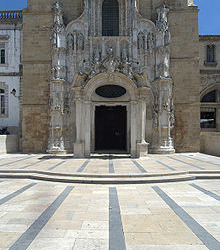

In 1146, Afonso married Mafalda, daughter of Amadeus III, Count of Savoy and Mahaut of Albon, both appearing together for the first time in May of that year confirming royal charters. They had the following issue:
Henrique (5 March 1147 – 1155 named after his paternal grandfather, Henry, Count of Portugal, he died when he was only eight years old. Despite being just a child he represented his father at a council in Toledo at the age of three;
Urraca (1148–1211), married King Ferdinand II of León and was the mother of King Alfonso IX. The marriage was subsequently annulled in 1171 or 1172 and she retired in Zamora, one of the villas that she had received as part of her arras, and later at the Monastery of Santa María in Wamba, Valladolid where she was buried.;
Teresa (1151–1218), Countess consort of Flanders due to her marriage to Philip I and Duchess consort of Burgundy through her second marriage to Odo III;
Mafalda (1153 – after 1162). In January 1160, her father and Ramón Berenguer IV, Count of Barcelona, negotiated the marriage of Mafalda to Afonso, future King Alfonso II of Aragon who at that time was three or four years old. After the death of Ramón Berenguer IV in the summer of 1162, King Ferdinand II of León convinced his widow, Queen Petronilla, to cancel the infante's wedding plans with Mafalda and for Afonso to marry instead Sancha, daughter of Alfonso VII of León and his second wife Queen Richeza of Poland. Mafalda died in her childhood at an unrecorded date.
Sancho, the future King Sancho I of Portugal (11 November 1154 – 26 March 1211). He was baptized with the name of Martinho for having been born on the saint's feast day.;
João (1156–25 August 1164);
Sancha (1157–14 February 1166/67), born ten days before the death of her mother, Sancha died before reaching the age of ten on 14 February according to the death registry at the Monastery of Santa Cruz (Coimbra) where she was buried.
Before his marriage to Mafalda, King Afonso fathered his first son with Chamoa Gómez, daughter of Count Gómez Núñez and Elvira Pérez, sister of Fernando and Bermudo Pérez de Traba:
Afonso (1140–1207). Born around 1140,according to recent investigations, he is the same person as the one often called Fernando Afonso who was the alferes-mor of the king and later Grand Master of the Knights Hospitaller. His presence in the court is first recorded in 1159. In 1169 he succeeded as alferes-mor his half-brother, Pedro Pais da Maia, the legitimate son of his mother and Paio Soares da Maia.
The extramarital offspring by Elvira Gálter were:
Urraca Afonso. In 1185, her father gave her Avô, stipulating that this villa was to be inherited only by the children that she had with her husband Pedro Afonso de Ribadouro (also known as Pedro Afonso Viegas), grandson of Egas Moniz, which could indicate another previous or subsequent marriage. In 1187, she exchanged with her half-brother, King Sancho, this villa for Aveiro. She died after 1216, the year she made a donation to the Monastery of Tarouca.
Teresa Afonso. In some genealogies she appears as the daughter of Elvira Gálter, and in others as the daughter of Chamoa Gómez. Her first marriage was with Sancho Nunes de Barbosa with whom she had a daughter, Urraca Sanches, who married Gonçalo Mendes de Sousa, the father of Mendo Gonçalves de Sousa known as "Sousão".Her second husband was Fernando Martins Bravo, Lord of Bragança and Chaves, with no issue from this marriage.
King Afonso was also the father of:
Pedro Afonso (died after 1183), Lord of Arega and Pedrógão, mayor of Abrantes in 1179, alferes of King Afonso I between 1181 and 1183, and Master of the Order of Aviz.
27 notes
·
View notes
Text
Writer Journal Entry
{Saturday, September 29th TUMBLR 2018}
//Summary format for the Machines of War series! “Spoilers” below.
—0 (Mournful Blues): Cardinal is built in secret, and develops a strong sense of reckless devotion to saving others as well as a sense of self. He's closest to his C.O., though he adores his father. Things start to go wrong, and he ends up in a test chassis. When that fails too, they discover that the failure is software-based, and there is talk of erasing him. He runs away.
Living in the streets eventually takes him to Kansas City, which—while safer than Monstropolis and Chicago—is still dangerous. He takes shelter with others in a homeless community, and becomes fascinated with jazz music. This all comes to a grinding halt when a building catches fire in a thunderstorm. He saves the people inside (including a family with a young girl), but goes Offline in the process.
His injuries remind him of his approaching mortal end, and drive him to seek Dr. Light out of a misinterpretation that Light had found a way to fix him. It turns out instead that Light had developed the concepts for Rock and Roll, and was using his old core as a "brand new" technology. He is very upset, and runs off blindly after bumping into Mikhail. He meets Señor Gonzales shortly before he dies.
Wily, for his part, moves out of the office, with plenty of foreshadowing for Broken Winter as he talks to Mikhail.
===================
—1 (Sons of Anarchy): Wily is brought on board to help build "the first" AI&As, due to old friendships and so on. Rock and Roll don't really like him, however, and he is lonely. There are also foreshadowing signs of envy, and he clashes with Light on philosophy perspective.
Development of the Industrials appeases him, and he's allowed to pull his own teams together. He chooses to recruit internationally (outside of Europe) from lesser-known and unknown individuals in the scientific community (not academics), which raises a big to-do. Mikhail is one of the ones recruited; he is second-in-command on the DLN-005 project.
Mikhail ends up taking over the DLN-005 project and writing his own coding for it after Wily has to drop the project due to health problems: Wily chose to retain his focus on the troublesome DLN-008 project. He eventually has some success by using the first fully written DWN_OS software, and he gives Tobias emotions.
Tobias comes Online initially in awe of Dr. Light, but is neglected in favor of his brother, Rock. He and Dr. Wily grow very close to one another, and he also becomes good friends with David (and meets Mikhail in the process). He grows to love radio and shares his father's fervor for ideas re: robot rights/roles in society, and starts looking forward to his testing being over.
Unfortunately, he is destined for an isolated existence. His protests at learning this lead Dr. Light to realize that Tobias is fully realized and has emotions. Dr. Light becomes furious and gets into a loud argument with Wily, which Tobias, Mikhail, and just about everyone else overhears. When he threatens to erase Tobias, the electric 'bot panics and runs away. He hides with Dr. Wily for a while, and asks for Wily to upgrade himself and the other Industrials. Wily agrees after learning about the projects for Timeman and Oilman.
The Industrials all agree to split up after they are fully realized, with Snow being his adorable self. They go their separate ways, except for Snow traveling with Fire.
Tobias ends up making broadcasts, fleeing from town to town, and eventually ends up in Monstropolis. His grand coup de grâce at his favorite radio tower gets him cornered and attacked, causing him to lash out in fear.
Not long after this, he gets news that his brothers have died. Surprised and worried, he contacts David and agrees to meet up with him. Unfortunately, they're too late: Snow and Fire get cornered, and Tobias ends up hearing his brother's final words.
This shatters his sanity, and he's catatonic for a while. He manages to encrypt a fair amount of data before the Blue Menace finally hunts him down as well. In the ensuing fight, he discovers it's actually his older brother, Rock. His attempts to reason with him are useless, and he's literally ripped to pieces.
This drives Wily utterly MAD, and he rants in a vow of revenge.
Mikhail, of course, is detained in questioning, which goes on for so long that he's unable to get there in time to stop Tobias from messing with the database. He does see that David is truly alive, however. He's sent back to Russia, but he's being watched…
===================
—1.5 (Moral Compass): Wily brings Cardinal back to life after discovering him. He hopes that Cardinal will be like a son to him, but Cardinal is furious when he learns about what happened to the First Gens.
He runs off, back to Kansas City. He's recognized via dogtags by the girl he saved, and she tells him about the Mad Hatter Café. He initially gets a job as a janitor there, and sleeps on the roof. He notices the secret trap door during a tornado warning, but says nothing.
After telling the truth to the girl, she introduces him to the REAL purpose of the café, passing him off (with technical truth) as a homeless soldier with memory problems.They gladly take him in, to his initial guilt.
He slowly adapts to his new life, and eventually learns of the hacking side to the Hatters. "They explain that most of the time, it’s to set up truly private interactions or transactions, in a setting not monitored by the people who would hunt them down. He feels sad (but not too surprised) to hear that humans live in hiding for their identity, too."
Once he gets word from Wily, he takes the risk of traveling back to see him despite the Hatters being more like a family than Wily was. He meets Metal for the first time, and feels a bit guilty when he notices Wily isn't completely sane.
Back with the Hatters, he works more on self-repairs and they assure him he's safe and welcome with them. He decides he wants a new name, and settles on "Cardinal" after consultation with the thesaurus. "When given a hard time for this, he grins because he knows he’s been fully accepted.
He contemplates what he wants to have on his birthday, with the Hatters getting him a fake ID as a present after having been with them for so long. He decides on March 8th, but isn’t sure why. Elsewhere, Enigma and Chorus are "…" at seeing this influence starting to rub off on the timeline
In the end, he purchases his motorcycle, and finally gets the chance to live out his literal dreams. He finds it exhilarating and freeing.
======================
—2 (Hora de Muerte): Carlos is built and spends time with his brothers in the lab, a bit in awe of the world around him (and fairly close to Pisces). His oldest brother's gory details about blood drive him to become a pacifist. Unable to stand being cooped up in a lab, he's eventually allowed to run loose. A run-in with Highway Patrol and the National Guard spooks him, but Cardinal gets him out of the jam and sends him down to Texas.
Once there, he meets Señor Gonzales, who takes him in and raises him like a son. He becomes a member of the community over time, and gets several other teenaged friends.
His struggles between his two families and his own identity continues over the course of several years, but inevitably, the Blue Menace sets out once again. Carlos's decision to stay with his new family and life is disrupted by the destruction of Lower Monstropolis, and the subsequent visit to the horrific wreckage.
He arrives too late to save either Pisces or Jaden, and nearly kills Rock in a berserk rage. He ends up trashing the lab he was built at, and returns home to Texas to spend out the rest of his days there.
In the end, he is found, and forced to fight to the death. Everyone in the community (other than Pops and Cruz) is shocked to see that he was a robot all along.
Due to certain hardware failures, his self-destruct fails to go off. His body is confiscated to be studied via reverse-engineering.
========================
—3 (Empire of Corruption): Wily and Light start working together again. Their intentions both start off good, and a lot of good comes from it; Nico is built and allowed to be Roll's companion, Siamini is built and works as a lab assistant, Rush is built with transformative abilities, etc. But Wily isn't fully over what happened, and becomes mad again when he discovers Carlos's old, forgotten, dismantled chassis in storage. When Spica falls to Earth in Korea, he sends Snakeman out to retrieve him.
He starts working on reprogramming both Spica and the Third Generation Industrials, but Carlos wakes up in the process. Carlos escapes into the Cloud, ending up forced to take shelter in the very database he'd trashed long before.
Meanwhile, Shadowman wakes up and escapes, killing Snakeman in the process. Nico and Siamini are forced to deal with the fallout, but they are all soon reprogrammed. Everyone manages to escape, but they handle the situation differently: Viper chooses to bully and spy on his brothers, Siamini frets but obeys in fear, and Nico is more focused on his secret meetups with Roll.
Shadow, for his part, travels down to Texas, running into Cardinal along the way. Cardinal decides to break away from Wily at last, and Shadow talks with Pops about Carlos.
While he focuses on getting an emotions program and getting Carlos a body, Cardinal focuses on saving what Third Gens he can. He gets some success with Siam (though Gemini still dies), and comes just in time to prevent Rock from destroying Nico.
Everyone ends up coming together at the old lab. Siam and Nico help repair Speedy, and Cardinal and Shadow fight the Menace to stall for time. Cardinal rages against his brother, and they all manage to escape.
Cardinal goes back, but fails to come in time to help with the Gamma incident. He does dig Rock out of the rubble, but doesn't check for Wily.
The Rebel Angels decide to live down in Texas. Meanwhile, Rock and Roll come into conflict over the truth about Nico, and Dr. Light sees Mikhail at a convention. (The Russian does not have flattering things to say.)
========================
—4 (Broken Winter): Cardinal grows suspicious when there's no news of Wily's death. His investigation takes him to the scene of the incident, and then to what's left of the old lab, where he meets Jazz in her Combat form. (He eventually puts her into a Civilian form, as Wily had been working on those in Empire of Corruption. ) He learns that an intern's codes were used to erase data on Gamma, and grows more suspicious. A fire breaks out before he can investigate further.
He eventually learns about Mikhail, and recognizes him from many, many years ago. He calls in some favors with the Mad Hatters to get a false identity to travel abroad with, deciding to go to Russia. Meanwhile, Tobias and David wake up in the Cloud after so long in an encrypted state.
Viper (who had been rebuilt) kidnaps Mikhail and Kalinka on Wily's behalf, and proceeds to physically and psychologically torture the Russian Doctor into submission for Wily's latest scheme.
(Meanwhile, Anubis discovers evidence of Jupiter in a massive and elaborate underground temple in Egypt. Before he can report his findings, however, he is forced to come back to Siberia. Once he realizes that he’s going to be reprogrammed, he locks his memories such that only Dr. Cossack can unlock them.)
Cardinal's adventures through Eurasia take him across Italy, Egypt, and Siberia, to name just a few places. He fools Wily into thinking he's on his side, and gets access to Kalinka that way. While he's unable to save Anubis, he does save Skull, Keltso, and Digger. Fights with various feds take place along the way.
He arrives just in time to prevent Rock from killing Mikhail, and he takes them to the hospital before blowing up the Siberian Citadel and leaving Rock to deal with Wily.
Mikhail's recovery in the hospital is overshadowed by the possibility he might be executed for his role in what happened, but Dr. Light steps in and "is a good" ( "for once" as Cardinal would say) by putting in a good word, getting Mikhail a good legal team, paying for medical bills, and eventually agreeing to pay for the resources to rebuild the DCNs. Mikhail himself becomes an American citizen and enters Witness Protection under the identity Michael Kodak and his daughter, Katrina Kodak.
Later, sorting out the nitty-gritty gets Mikhail rights to rebuild David via loophole. (Concept art for his new design is later used to build Chorus and Refrain….) Tobias also eventually gets rebuilt. Cardinal gets much-needed repairs, but brushes off Mikhail's warnings that Wily is a dangerous man to make enemies with.
Eventually, Mikhail upgrades Rock's blaster cannon after patching his combat program. Rock asks him about the DCNs and Cardinal, to which Cossack remarks that Mega would know more than he would. Rock gives Mikhail the medals he got for saving the world, as he suspects that Cardinal would come into contact with Mikhail later. Rock uses careful wording to suggest to various authorities that Cardinal is dead, just in case…
========================
—AO (Allies Obstruct): The Rebel Angels befriend Xelbots outside of time, and are devastated when that world goes through an apocalyptic breakdown—
Okay, yeah, not actually part of the series's timeline canon, but this is roughly when it takes place in perspective.
========================
—5 (Prodigal Son): Cardinal gets publicly framed for the kidnapping of Dr. Light while he's out visiting the Hatters. He is now known by the feds to still exist, and outed to the public as a robot. The Hatters hide him for a little bit, with most of the members shocked to realize he's an AI&A; he tells them the full truth of the matter, and leaves the city for their sake, to confront the true guilty party.
Meanwhile, Mikhail has to deal with suddenly being tasked with taking care of Rock, even though he doesn't really believe Cardinal would be so violent. He has enough doubts/concerns that he cuts off RMDC access to the Rebel Angels, though.
In between the chaos of Gravity and Viper terrorizing Light and Cossack AND the Rebel Angels, Eugene (Starman) discovers an anomaly forming in the distant reaches of space, somewhere around Venus.
There's some internal conflict with the family on how to handle this, but Cardinal still goes to confront the Fifth Gens. It proves to be an incredibly dangerous task, and he manages to get Eugene more on their side. His confrontations with Gravity are only stopped by Rock's arrival, at which point Cardinal goes off to confront Dark Man. Viper interrupts him, and is defeated again for his troubles.
Rock and Cardinal fight, and it goes very badly until Darkman reveals himself at the last moment but doesn't manage to finish Rock off. Cardinal tosses Rock some supplies before warping off to nurse his own wounds.
Later, Mikhail apologizes for his reaction, offers again to fix Cardinal's core or for them to stay in Alaska. Cardinal declines and asks Mikhail to tell the press and the authorities that he is actually still dead; Dr. Light finally realizes that Cardinal is Blues and tells Mega and Roll of the existence of DLN-000.
Eugene is eventually repaired by Dr. Cossack, and offered a place at Light Labs. He declines fearfully, and runs off before the point can be argued. Cardinal notes that he suspects that Eugene needs some independence to decide things for himself, and will choose a “side” once he’s had some time to think.
========================
—6 (Tournament Trifecta): Wily repairs a number of robots for a tournament, including Isaac, Viper, Jaden, Pisces, and Metal.
As other people start building robots, the Beta Boys are faced with the possibility that they might be able to come out of hiding and stop living as fugitives. They are uneasy when there is a public invitation to join a combat tournament, suspecting it an excuse by various governments to gather data on top-notch combat robotics.
Things take an unexpected turn when they get a distress call from one of the contestants. They initially split up: Tobias and Carlos working to find information on the contestants (and the sponsors); David and Siam working with Dr. Cossack on schematics for armor upgrades that will be both more durable and possibly allow for a morph between hands and weapons for those who lack hands; Cardinal, Shadow, and Nico going to the arena to discern the source of the distress call.
While there, they come across the alarming news that Viper not only has returned, but he has entered the tournament and is fighting his way up the ranks. Shadow angrily tries to confront him, but is stopped when he is attacked by another contestant, who stops them from entering the main area of the arena (where Viper is about to fight Yamato Man). Before they can figure out who he is, he runs off. They try and chase him down when suddenly he gets pulled aside to participate in a fight of his own against Wind Man.
They split up again—Cardinal to monitor the stranger, and Nico and Shadow to confront Viper after the fight ends. Surprisingly, the stranger is revealed as Jaden and Viper loses rather terribly, about to be deactivated when Shadow steps in. Cardinal rescues Jaden and Shadow prevents Yamato from killing Viper so that they could learn why he was there. They learn the true purpose of the tournament when Mr. X comes on over the speakers and reveals the truth. Shadow is forced to leave Viper behind in order to rejoin his brothers and cover for their escape as the arena goes into panic.
As Cardinal, Jaden, Nico, and Shadow take refuge with the Hatters, Mikhail contacts Toby's group in order to share information. He urges them to get to safety, as he suspects Wily is behind this and that Wily may have ordered their termination. Tobias spurns the notion but accidentally fries the circuits of their console in the process. He is forced to repair them himself as Carlos has become rather distracted by some of the contestant designs, which seem familiar to him.
Due to increased security, Cardinal's group is forced to lay low in KC for a while. They work on repairing Jaden, who explains that he had been rebuilt for the contest and entered in in order to draw the Rebel Angels out. Cardinal decides to leave after hearing this to investigate if any others had been reactivated. He uses Jaden's access card (and an ID given to him by Cossack) to enter into the Arena (disguised in full armor). While there he comes across some useful equipment, so he takes it back with him to study, sending most of it off to Mikhail.
Dr. Cossack tests out some of the new equipment and armor with Snow as Kalinka and Keltso watch. They determine the use of the energy balancer, and Snow begs for Dr. Cossack to build his family a cat. They are interrupted by an attack on the fortress from Blizzardman. Keltso goes out to fight him and tells Snow to stay back, but Snow follows anyway and saves him from being shattered by ice. Snow and Blizzard get locked into an elemental domination battle, which ends with Snow being overpowered as he refuses to actually attack. The fight is interrupted by Mega, allowing Keltso and Snow to escape with Dr. Cossack and Kalinka.
Cardinal's group joins up with Snow's group when they arrive in KC. After swapping stories, Cossack gives Cardinal an Energy Balancer. While the others are busy repairing Jaden, Cardinal goes off on his own to give the Balancer to Mega. While he is gone, the others discuss his mysterious past and behavior and go out to eat.
Cardinal travels and meets up with Mega before he fights Tomahawk. He tries to leave, but Mega stops him by saying he knows who he is now. He calls him "Blues" and asks him why he never told him the truth, why he had fought him instead. Cardinal listens as Rock begs him to go back to the labs and speak with Dr. Light. Cardinal calmly tells him to focus on defeating Wily, and then leaves before Mega can protest further.
He rejoins the others. With Cossack's help, they all travel to join up with the rest of the Beta boys in Texas. Speedy is overjoyed that Jaden is alive again, and the two share a happy reunion. After hearing news of Wily's defeat and arrest, everyone goes out to celebrate.
========================
—7 (Depths of Discord): Cardinal now has to deal with Beowulf, Wily's latest creation. This is a frustrating affair, as he is inexperienced and facing a foe he simply cannot defeat at his current stage in life. Keeping the two of them from killing one another and him is a taxing affair. Alucard kicks Beowulf to the curb, and Cardinal intervenes.
Eventually, Cardinal's intervention comes with the cost of his own Shield (which is one of the few things he's owned from the start) in order to stave off Rock's combat programming from finishing him off. In the end, he has to intervene to keep Rock from killing Wily, which he knows Rock would come to regret later on, and leaves while fairly exhausted.
While he does manage to get everything back, he also manages to get Beowulf to hand over the Super Adaptor.
Eugene also finally returns, this time with troubling news from space…
========================
—8 (Stellar Disaster): Cardinal is once again forced to get involved for Beowulf's sake, and also sees the reawakening of at least one Stardroid, probably several—which of course leads to other problems with Shadow.
Half of the actual conflict isn't even with the Robot Masters: it's with the Stardroids. They don't bother with the other RMs, letting Rock deal with that while they handle the big guys. Shadow plays a major role in taking them down, though he then goes missing.
Cardinal has to intervene repeatedly for the fish's sake, but ends up getting infected with Evil Energy just as much as Rock due to the both of them getting exposed at the same time. He survives and wakes up before Rock does, but he's horribly weakened by the experience.
========================
—8.5 (Royally Blindsided): "MoW!MM&B is…. … …just. || "It's only a scratch…" || Really, Cardinal? Why is nobody surprised? || After he's repaired from being CUT IN HALF, he goes back to fight King and ends up nearly one-shotting his core by using a highly charged shot from his plasma blaster. He nearly explodes and is teleported off by the man who nearly killed him not too long ago, and later—after "just good enough" repairs, before Mikhail's finished with them—infiltrates one of Wily's lairs and narrowly talks his way out of a fight with Forte as well."
In other words, Cardinal gets sliced in half, and the narrator becomes Beowulf as he is finally given the first chance to actually do something that matters all on his own. Beowulf deals with the difficulty of confronting two enemies at the same time, especially with Rock being such a great and terrible enemy. Cardinal manages to get repaired enough to intervene anyway, twice.
========================
—9 (Scarred Reflection): Will be many cross-reference feels re: being erased, destroyed, decommissioned. Pisces has secretly been hanging out with Splash, keeping her safe (much to the chagrin of his brothers).
"One long nightmare, with a number of Industrials starting to lash out in despair. Cardinal has to deal with keeping the family together and out of trouble in the middle of what threatens to be a horrific disaster—the Industrials in question were only given free will, like with the First Gens, with Wily taking advantage after the fact due to being reminded of how things played out with Tobias. Cardinal has to fight his way through and try to save as many of the Industrials as he can, and then (yet again) is forced to save Rock's chass when he gets in over his head."
========================
—10 (Fevered Fugue): Robosickness madness grips the world. Bots are going berserk. Why does this sound and physically, painfully FEEL familiar to our heroes?
The COMBAT_DLN.EXE program gets loose and becomes fully viral, sending the whole world into the tizzy that the Mighty Numbers would face on a "merely" national scale. He outright teams up with Rock to try and find a cure: Rock working with Light and Cardinal working with Mikhail. Another violent argument between Light and Wily as it's revealed that the virus is the result of Light's work breaks out—leading to Wily to storm off with the cure and attempt to take advantage of the situation, much to Cardinal's chagrin. While on the way to confront him, however, Cardinal collapses from the effects of the virus; it's caused him to overheat in a way that he can no longer convert energy from his core into healing surge. Rock's prototype "cure" helps clear his mind, but the damage to his already fragile state is not so easily reversible. He manages to struggle on and eventually confronts Wily for the last time—and then leaves him to die, because he's learned from his mistake of MM3 when it comes to taking pity on the crazed Doctor.
========================
—11 (Grinding Gears): It turns out that Wily’s software was not the ONLY work of his from the old days that was stolen…
========================
—XOver (Temporal Echoes): Due to observation of dangerous anomalies in spacetime, and Rock Light’s inability to handle them, Dr. Light was called upon to create a new robot that was capable of resolving the threat. He worked hard on the blueprints for the hardware, but ultimately failed to produce a working copy of software.
Desperate, the powers that be (with Dr. Light included) begged the world’s best (sane) AI&A coder to join the project: one Dr. Mikhail Cossack.
Dr. Cossack agreed, but only under very strict conditions. Chief among them were the two main points regarding ownership and production: the unit would be considered a DCN, with Dr. Light acting as a subcontractor for the construction process. Therefore, it would be the legal property of Dr. Cossack’s privately owned LLC., subject to the legal ramifications of said ownership. Consequently, LightLabs, Inc. would NOT be allowed to mass-produce the unit under any circumstances, and any unapproved constructs produced using either the hardware or the software would be considered violations of patent and subject to seizure. Although these were not very well received, they were demanded and ultimately honored.
The project was a phenomenal success. Chorus transcended the confines of linear spacetime…
…and never returned.
None of the tracking measures seemed to indicate that Chorus got injured, destroyed, or captured, so the project leads were forced to conclude that he was either unable or unwilling to return. Since they still had a problem to deal with, Dr. Cossack agreed to make another construct—Refrain—using a slightly upgraded blueprint who would be tasked with the same defined purpose and the additional prerogative to search for and assist Chorus along the way…
========================
—T.
#OOC#cje#mowseries#Machines of War series#Mega Man#Mega Man Classic#Mega Man 2#Mega Man 3#Mega Man 4#Mega Man 5#Mega Man 6#Mega Man 7#Mega Man 8#Mega Man & Bass#Mega Man 9#Mega Man 10#Mega Man 11
2 notes
·
View notes
Photo

The Worst Kind of Tandem:
The Greedy Rich and the Desperate Poor.
by juddashley
In another gut-wrenching reality of power dynamics in the Philippines, the action thriller film “On the Job” is truly a masterpiece of cinematic realism. Set in Metro Manila, the film follows the story of two jailbirds: Tatang (Joel Torre), a veteran hitman, and Daniel (Gerald Anderson), an arrogant mentee of the former. The tandem comes after being hired by corrupt politicians in need of killing their enemies—an appallingly vile activity happening inside the prison cells of the city. The film, which is based on a true story, depicts this unexposed reality in the country in the most honest way possible. No sugarcoating, just facts. Director Erik Matti’s stylistic choice from the camera treatments up to the editing helps in further justifying the believability of the actors and the story itself—a crucial factor for a realist film.
Upon dissecting every scene of the film, Matti seemingly chooses shots indicative of its characters’ situation rather than just being a frame of reference. This can be seen in all of Madam Thelma’s (Vivian Velez) scenes. Most of her parts, if not all, are taken in close-up or extreme close-up shots, restricting the viewers from fully seeing her identity. We only get to see a glimpse of her—of her eyeglasses, of her smoking—but never as a whole. These shots build the mysteriousness that comes with her role in the story: The Middleman. And in her character, anonymity is everything. This explains the choice of the shot in her scenes as it makes the character seems hidden, as to which her role requires. Another example of this is the scene where Tatang calls her daughter Tina (Empress Schuck) inside of his prison cell. The scene is taken in a wide shot, allowing the viewers to see not just the character but the environment he lives in. It also establishes his relationship with his surroundings. The shot depicts the prison mates sleeping on the rugged floor whilst Tatang comfortably sits on his bed having his illegal call. This suggests how the character is somewhat above in comparison to others—a perk that comes from his job.
A variety of angles is used all throughout the film, further heightening the experience. Though there are particularly two scenes that stand out because of their exemplary use of angle. Firstly, when one of the targets, Pol (Lito Pimentel), is explaining how the contract killing works to his police friend Joaquin Acosta (Joey Marquez), the scene goes back and forth between them and the two hitmen. The first part shows Tatang and Daniel walking on a bridge, leaving the jail. This scene is shot at a low angle. The second part shows the two walking again on a bridge, but now entering Pol’s place. This scene, however, is shot at a high angle. The contrast between these two angles is reflective of the characters’ situation. The former part indicates Tatang and Daniel instituting their superiority, hence the low angle; the latter, on the other hand, indicates Pol’s vulnerability and endangerment, hence the high angle. Remember that all of these are happening whilst Pol’s narration is in the background. A thrilling experience, indeed. Secondly, when Joaquin finally gets a hold of Tatang but remains adamant about his involvement in killings. The police then point his gun at Tatang’s head, hinting at the hitman at what could happen. The use of eye level angle in showcasing this scene is immaculate as it perfectly portrays the raw emotion of the character—of his personal dilemma, allowing the viewers to connect and sympathize. It also intensifies the tension surrounding the scene, making it even more riveting.
One of the most intriguing elements used in the film is the lighting which, again, seems to be deliberately done in connection with the characters’ situation. The film introduces Daniel as this cocky jailbird who enjoys being in the spotlight. However, when he asks Tatang for his mentorship on how to properly handle their job, the first advice he gets is to keep a low profile—something that the conceited protégé struggles in doing so. At the beginning of the film, we get to see Daniel in a clear picture with the use of high key lighting. But the scene where the camera follows the jail guard counting the number of prisoners, the camera stops as Daniel sits and approaches Tatang, now with low key lighting. This illuminates the surroundings and puts Daniel in dimmer lighting—out of the spotlight—signaling his start of keeping a low profile. Another good use of lighting is evident in the scene where Tatang gets scolded by Madam Thelma for failing to kill their target. He then waits for Daniel in an alley whilst smoking in distress. The scene uses silhouette lighting, disallowing the viewers to see the character but his shadow and the smoke. This further dramatizes the visual storytelling. It also shows the director’s intention of hiding the characters after the mishap.
The color grading of the film heavily relies more on the softer color palette. The use of a blue-green undertone presents desaturation that matches well with the depressing premise of the film. This straightforwardly helps the viewers feel the emotion and grasp the feelings of struggle and conflict that the material conveys. This color scheme is evident in the majority of the film. Though, a hint of red color surprisingly appears in the most devastating scene. When Tatang finally gets his parole, Daniel congratulates him and starts a heart-to-heart talk. In this scene, the usual blue-green undertone is used but now mixed with a subtle yellow color—indicative of the sunlight that comes from the window. This minimal touch of yellow signifies hope, a sneak peek of a bright future that lies ahead for Tatang. However, as the scene progresses, that subtle yellow color diverts into a more solid red color, covering half of the Tatang’s face. The color red exudes the strongest emotion amongst all colors according to the psychology of color. It is commonly associated with danger, aggression, and even violence. The sudden appearance of this color makes sense after seeing how the scene ends: Tatang mercilessly stabs Daniel to death. The color, aside from being a symbol of the violence that is yet to come, amplifies the gravity of the scene. It makes the betrayal even more traumatic and shattering for the viewers.
The film gives the audience a complete viewing experience, all thanks to its excellent use of sound. It helps in building the realisticity of the scenes, providing life to the characters and the material. The use of both diegetic and non-diegetic sounds contributes to the in-depths of the scenarios, checking out every action thriller film’s must-dos. A perfect example of this is the opening scene of the film wherein Tatang and Daniel roam around the city of Manila, mixing in with the crowd and the chaos brought by the festival. And of course, the tandem is not there for a celebration but for a killing. The film’s sound department is smart for utilizing the sound of the drums alongside the environmental noises to build the scene’s suspense. It is noticeable how the sound’s volume correlates with the hitmen’s actions—the closer they get to their victim, the higher the volume goes. The scene ends in a perfect bang, replacing the drumbeat to gunshots resulting in a complete mayhem of the city. One exemplary use of sound can also be found in the ending scene. For context, the film introduces Tatang as this merciless hitman yet a loving father whose sole motive is to provide for his family’s needs. This humanizes the character and makes the viewers capable of seeing him as somehow a good person. Fast forward to his parole, Tatang may have tasted his much-awaited freedom but the conscience of killing Daniel and his wife’s infidelity put a heavy weight on him. This pushes him into doing something unimaginable—killing his own wife. The scene happens on a rainy day which makes the sound of the pouring rain even more depressing. But what is more spine-chilling is when the film’s OST “Maskara” by Juan de la Cruz band plays whilst Tatang is walking in the rain after murdering his wife. The lyrics of the song say, “Hubarin mo ang iyong maskara, ang iyong tunay na katauhan ay nakatago lamang sa’yong likuran ... (trans: Remove your mask, your true identity is just hidden behind your back). The metaphorical line suggests the character’s personal and moral dilemma—of who he truly is and what he stands for. This questions the character’s real intention and reduces his figure of being a good father—that maybe after all it is just a façade, a mask.
The film overwhelmingly consists of contrasting themes—from the rich and the poor, good vs evil to life and death. These recurring themes are evident all throughout, should you dissect the material thoroughly. However, this can only be achieved by ensuring the cohesiveness of all the elements used, the mise-en-scene—and the film succeeds in doing so. One notable example of this is when Daniel wanders around the jail. The character is placed at the middle of the frame, facing the camera, taken in medium shot with eye level angle, allowing the viewers to see not just the character’s actions but the setting as well. The camera follows Daniel as he roams around the vicinity, showcasing the meticulous work of the production designers. The set design perfectly depicts what a prison looks like in real life, not romanticizing the place. In this continuous shot, it gives the audience a full perspective of the environment and the people that the characters live with. The whole scene also establishes Daniel’s superiority in the place. The contrasting theme shows at the end of the scene when a much bigger jailbird confronts the character’s special treatment. This confrontation shackles Daniel’s position, accepting his inferiority. A similar execution can be seen in one of the killing scenes of the hitmen. The camera follows both Tatang and Daniel wandering around a pig slaughterhouse. The placement and composition of the characters around the frame enable the viewers to see the nature of the setting and their actions. The set design, once again, never fails in accurately portraying the place. Shot continuously, the scenarios from killing the target to leaving the crime scene are executed seamlessly. Moreover, a contrasting theme appears. After Tatang and Daniel killed a woman in a slaughterhouse which signifies death, they enter a room of people celebrating a christening—an epitome of life.
Here comes the most crucial part of it all, the editing. The film profoundly uses a variety of editing techniques in effectively portraying the story. It is observable that fast cutting has become some sort of a default approach for the editor, which is a great choice as it implies the chaos most of the scenes required. Though the random zoom in for some scenes may not be the best option to go with as it feels forced and unnecessary instead of helping build a dramatic effect. Nonetheless, the transition and sequencing of the story are constructed cohesively, ensuring its fluidity. This drives the storytelling in a smooth direction, leading the viewers to fully understand the film. The use of plot devices is also evident in the material which helps the story go forward and adds up spice to it. The most notable one is the False Ending. It has been explained multiple times in the film how the bosses of Tatang and Daniel like to cut loose ends by killing them. This fact automatically makes the viewer assume that Tatang is most likely to end up getting murdered as his parole is near approaching, thus his retirement. Moreover, the existence of his young protégé justifies this assumption even more. This is where the plot device comes in when the audience has already formulated an ending for the story, only to be met with a completely different ending—Tatang killing Daniel and continuing his job as a hitman. This elevates the story in a more interesting and thrilling way by injecting unpredictable reveals.
The ensemble of this film is a dream team a production house could ask for. With the high-caliber cast, it is no doubt that the characters are successfully brought to life and effectively portrayed. The characterization is on point. The role given to each actor seemingly fits them well, making it as if they are not acting at all. Joel Torre is a natural actor. He embodies the different personas of his character—from being a hitman, a loving father to being a mentor—in distinctive approaches. Proving his flexibility as an actor. On the other hand, Gerald Anderson’s choice of mannerisms and speech pattern contributes to rendering his character’s trait. He perfectly presents the naivety and arrogance of the character through his gestures and delivery of lines. The acting choices of every actor in displaying their characters’ motives and intentions are necessary and well thought out. No actor lacks in any department and gives justice to the material.
In conclusion, “On the Job” is more than just your regular action thriller film, it is a cinematic experience. A perfectly-crafted masterpiece that continues to pull you in. It is immersive. It is thought-provoking. It is reality. It unapologetically unravels a devastating truth about the Philippines and its political system. An exposé to those greedy rich politicians who continue to exploit the desperation of the poor.
#film#movie#cinema#film review#movie review#on the job#erik matti#philippines#local film#indie film#essay
0 notes
Photo
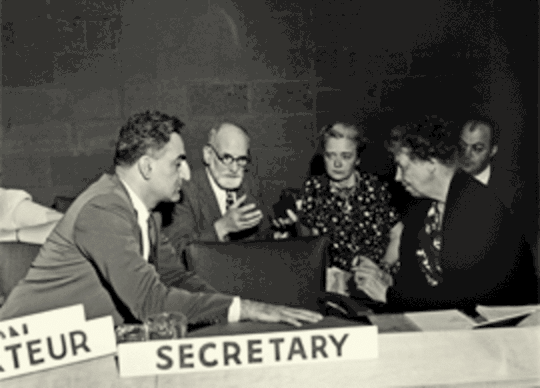
Three members of the UN Commission on Human Rights in
conversation before a meeting.
Left to right: (Malik, Cassin, and Roosevelt).
Credit: UN Photo.
THE FIRST GLOBAL STATEMENT OF THE INHERENT
DIGNITY AND EQUALITY OF ALL
Throughout history, conflict, in the form of wars or as popular uprisings, has often come in reaction to inhumane treatment and injustice. The English Bill of Rights in 1689, drafted after the English Civil Wars, sprang from the people’s aspiration for democracy. Exactly a century later, the French Revolution gave rise to the Declaration of the Rights of Man and of the Citizen and its proclamation of equality for all. But the Cyrus Cylinder, issued in 539 B.C. by Cyrus the Great of the Achaemenid Persian Empire (ancient Iran) after his conquest of Babylon, is said by many to be the first human rights document, and the Pact of the Virtuous (Hifl-al-fudul), concluded by Arab tribes around 590 AD, is considered one of the first human rights alliances.
After the Second World War and the creation of the United Nations, the international community vowed never again to allow atrocities like those of that conflict. World leaders decided to complement the UN Charter with a road map to guarantee the rights of every individual everywhere, always.
The document they considered, and which would later become the Universal Declaration of Human Rights, was taken up at the first session of the General Assembly in 1946. The Assembly reviewed this draft Declaration on Fundamental Human Rights and Freedoms and transmitted it to the Economic and Social Council "for reference to the Commission on Human Rights for consideration . . . in its preparation of an international bill of rights." The Commission, at its first session early in 1947, authorized its members to formulate what it termed "a preliminary draft International Bill of Human Rights". Later the work was taken over by a formal drafting committee, consisting of members of the Commission from eight States, selected with due regard for geographical distribution.
The People behind the vision: the UDHR Drafting Committee
The Commission on Human Rights was made up of 18 members from various political, cultural and religious backgrounds. Eleanor Roosevelt, widow of American President Franklin D. Roosevelt, chaired the UDHR drafting committee. With her were René Cassin of France, who composed the first draft of the Declaration, the Committee Rapporteur Charles Malik of Lebanon, Vice-Chairman Peng Chung Chang of China, and John Humphrey of Canada, Director of the UN’s Human Rights Division, who prepared the Declaration’s blueprint. But Mrs. Roosevelt was recognized as the driving force for the Declaration’s adoption.
The Commission met for the first time in 1947. In her memoirs, Eleanor Roosevelt recalls: “Dr. Chang was a pluralist and held forth in charming fashion on the proposition that there is more than one kind of ultimate reality. The Declaration, he said, should reflect more than simply Werstern ideas and Dr. Humphrey would have to be eclectic in his approach. His remark, though addressed to Dr. Humprhey, was really directed at Dr. Malik, from whom it drew a prompt retort as he expounded at some length the philosophy of Thomas Aquinas. Dr. Humphrey joined enthusiastically in the discussion, and I remember that at one point Dr. Chang suggested that the Secretariat might well spend a few months studying the fundamentals of Confucianism!”
The final draft by Cassin was handed to the Commission on Human Rights, which was being held in Geneva. The draft declaration sent out to all UN member States for comments became known as the Geneva draft.
The first draft of the Declaration was proposed in September 1948 with over 50 Member States participating in the final drafting. By its resolution 217 A (III) of 10 December 1948, the General Assembly, meeting in Paris, adopted the Universal Declaration of Human Rights with eight nations abstaining from the vote but none dissenting. Hernán Santa Cruz of Chile, member of the drafting sub-Committee, wrote: “I perceived clearly that I was participating in a truly significant historic event in which a consensus had been reached as to the supreme value of the human person, a value that did not originate in the decision of a worldly power, but rather in the fact of existing—which gave rise to the inalienable right to live free from want and oppression and to fully develop one’s personality. In the Great Hall…there was an atmosphere of genuine solidarity and brotherhood among men and women from all latitudes, the like of which I have not seen again in any international setting.”
The entire text of the UDHR was composed in less than two years. At a time when the world was divided into Eastern and Western blocks, finding a common ground on what should make the essence of the document proved to be a colossal task.
0 notes
Text
The future is in interactive storytelling
by Noah Wardrip-Fruin and Michael Mateas

Marvel’s new blockbuster, “Guardians of the Galaxy, Vol. 2,” carries audiences through a narrative carefully curated by the film’s creators. That’s also what Telltale’s Guardians-themed game did when it was released in April. Early reviews suggest the game is just another form of guided progress through a predetermined story, not a player-driven experience in the world of the movie and its characters. Some game critics lament this, and suggest game designers let traditional media tell the linear stories.

What is out there for the player who wants to explore on his or her own in rich universes like the ones created by Marvel? Not much. Not yet. But the future of media is coming.
As longtime experimenters and scholars in interactive narrative who are now building a new academic discipline we call “computational media,” we are working to create new forms of interactive storytelling, strongly shaped by the choices of the audience. People want to explore, through play, themes like those in Marvel’s stories, about creating family, valuing diversity and living responsibly.
These experiences will need compelling computer-generated characters, not the husks that now speak to us from smartphones and home assistants. And they’ll need virtual environments that are more than just simulated space – environments that feel alive, responsive and emotionally meaningful.
This next generation of media – which will be a foundation for art, learning, self-expression and even health maintenance – requires a deeply interdisciplinary approach. Instead of engineer-built tools wielded by artists, we must merge art and science, storytelling and software, to create groundbreaking, technology-enabled experiences deeply connected to human culture.
In search of interactivity
One of the first interactive character experiences involved “Eliza,” a language and software system developed in the 1960s. It seemed like a very complex entity that could engage compellingly with a user. But the more people interacted with it, the more they noticed formulaic responses that signaled it was a relatively simple computer program.
In contrast, programs like “Tale-Spin” have elaborate technical processes behind the scenes that audiences never see. The audience sees only the effects, like selfish characters telling lies. The result is the opposite of the “Eliza” effect: Rather than simple processes that the audience initially assumes are complex, we get complex processes that the audience experiences as simple.
An exemplary alternative to both types of hidden processes is “SimCity,” the seminal game by Will Wright. It contains a complex but ultimately transparent model of how cities work, including housing locations influencing transportation needs and industrial activity creating pollution that bothers nearby residents. It is designed to lead users, through play, to an understanding of this underlying model as they build their own cities and watch how they grow. This type of exploration and response is the best way to support long-term player engagement.
Connecting technology with meaning

Creating biased histories can be uncomfortable. 'Terminal Time,' by Steffi Domike, Michael Mateas and Paul Vanouse., CC BY-ND
No one discipline has all the answers for building meaningfully interactive experiences about topics more subtle than city planning – such as what we believe, whom we love and how we live in the world. Engineering can’t teach us how to come up with a meaningful story, nor understand if it connects with audiences. But the arts don’t have methods for developing the new technologies needed to create a rich experience.
Today’s most prominent examples of interactive storytelling tend to lean toward one approach or the other. Despite being visually compelling, with powerful soundtracks, neither indie titles like “Firewatch” nor blockbusters such as “Mass Effect: Andromeda” have many significant ways for a player to actually influence their worlds.
Both independently and together, we’ve been developing deeper interactive storytelling experiences for nearly two decades. “Terminal Time,” an interactive documentary generator first shown in 1999, asks the audience several questions about their views of historical issues. Based on the responses (measured as the volume of clapping for each choice), it custom-creates a story of the last millennium that matches, and increasingly exaggerates, those particular ideas.
For example, to an audience who supported anti-religious rationalism, it might begin presenting distant events that match their biases – such as the Catholic Church’s 17th-century execution of philosopher Giordano Bruno. But later it might show more recent, less comfortable events – like the Chinese communist (rationalist) invasion and occupation of (religious) Tibet in the 1950s.
The results are thought-provoking, because the team creating it – including one of us (Michael), documentarian Steffi Domike and media artist Paul Vanouse – combined deep technical knowledge with clear artistic goals and an understanding of the ways events are selected, connected and portrayed in ideologically biased documentaries.
Digging into narrative
“Façade,” released in 2005 by Michael and fellow artist-technologist Andrew Stern, represented a further extension: the first fully realized interactive drama. A person playing the experience visits the apartment of a couple whose marriage is on the verge of collapse. A player can say whatever she wants to the characters, move around the apartment freely, and even hug and kiss either or both of the hosts. It provides an opportunity to improvise along with the characters, and take the conversation in many possible directions, ranging from angry breakups to attempts at resolution.
“Façade” also lets players interact creatively with the experience as a whole, choosing, for example, to play by asking questions a therapist might use – or by saying only lines Darth Vader says in the “Star Wars” movies. Many people have played as different characters and shared videos of the results of their collaboration with the interactive experience. Some of these videos have been viewed millions of times.
As with “Terminal Time,” “Façade” had to combine technical research – about topics like coordinating between virtual characters and understanding natural language used by the player – with a specific artistic vision and knowledge about narrative. In order to allow for a wide range of audience influence, while still retaining a meaningful story shape, the software is built to work in terms of concepts from theater and screenwriting, such as dramatic “beats” and tension rising toward a climax. This allows the drama to progress even as different players learn different information, drive the conversation in different directions and draw closer to one or the other member of the couple.

Engaging with a couple on the rocks. 'Façade,' by Michael Mateas and Andrew Stern., CC BY-ND
Bringing art and engineering together
A decade ago, our work uniting storytelling, artificial intelligence, game design, human-computer interaction, media studies and many other arts, humanities and sciences gave rise to the Expressive Intelligence Studio, a technical and cultural research lab at the Baskin School of Engineering at UC Santa Cruz, where we both work. In 2014 we created the country’s first academic department of computational media.
Today, we work with colleagues across campus to offer undergrad degrees in games and playable media with arts and engineering emphases, as well as graduate education for developing games and interactive experiences.
With four of our graduate students (Josh McCoy, Mike Treanor, Ben Samuel and Aaron A. Reed), we recently took inspiration from sociology and theater to devise a system that simulates relationships and social interactions. The first result was the game “Prom Week,” in which the audience is able to shape the social interactions of a group of teenagers in the week leading up to a high school prom.
We found that its players feel much more responsibility for what happens than in pre-scripted games. It can be disquieting. As game reviewer Craig Pearson put it – after destroying the romantic relationship of his perceived rival, then attempting to peel away his remaining friendships, only to realize this wasn’t necessary – “Next time I’ll be looking at more upbeat solutions, because the alternative, frankly, is hating myself.”
That social interaction system is also a base for other experiences. Some address serious topics like cross-cultural bullying or teaching conflict deescalation to soldiers. Others are more entertaining, like a murder mystery game – and a still-secret collaboration with Microsoft Studios. We’re now getting ready for an open-source release of the underlying technology, which we’re calling the Ensemble Engine.

Making friends in ‘Prom Week.’ Prom Week, CC BY-ND
Pushing the boundaries
Our students are also expanding the types of experiences interactive narratives can offer. Two of them, Aaron A. Reed and Jacob Garbe, created “The Ice-Bound Concordance,” which lets players explore a vast number of possible combinations of events and themes to complete a mysterious novel.
Three other students, James Ryan, Ben Samuel and Adam Summerville, created “Bad News,” which generates a new small midwestern town for each player – including developing the town, the businesses, the families in residence, their interactions and even the inherited physical traits of townspeople – and then kills one character. The player must notify the dead character’s next of kin. In this experience, the player communicates with a human actor trained in improvisation, exploring possibilities beyond the capabilities of today’s software dialogue systems.
Kate Compton, another student, created “Tracery,” a system that makes storytelling frameworks easy to create. Authors can fill in blanks in structure, detail, plot development and character traits. Professionals have used the system: Award-winning developer Dietrich Squinkifer made the uncomfortable one-button conversation game “Interruption Junction.” “Tracery” has let newcomers get involved, too, as with the “Cheap Bots Done Quick!” platform. It is the system behind around 4,000 bots active on Twitter, including ones relating the adventures of a lost self-driving Tesla, parodying the headlines of “Boomersplaining thinkpieces,” offering self-care reminders and generating pastel landscapes.
Many more projects are just beginning. For instance, we’re starting to develop an artificial intelligence system that can understand things usually only humans can – like the meanings underlying a game’s rules and what a game feels like when played. This will allow us to more easily explore what the audience will think and feel in new interactive experiences.

‘Bad News’ is played in physical space. In the installation at Big Pictures in Los Angeles (for the Slamdance DIG exhibition), the player and actor were on one side of a wall (right) and the ‘wizard,’ who combs the lives of the generated characters for interesting story potential, was on the other (left). James Ryan, CC BY-ND
There’s much more to do, as we and others work to invent the next generation of computational media. But as in a Marvel movie, we’d bet on those who are facing the challenges, rather than the skeptics who assume the challenges can’t be overcome.
Noah Wardrip-Fruin is Professor of Computational Media at the University of California, Santa Cruz. Michael Mateas is Professor of Computational Media at University of California, Santa Cruz.
This article was originally published on The Conversation.
13 notes
·
View notes
Text
Movie review: 'Harry & Patty' is suprisingly engaging
New Post has been published on http://gr8gossip.xyz/movie-review-harry-patty-is-suprisingly-engaging/
Movie review: 'Harry & Patty' is suprisingly engaging


Patty is a kind, cheerful, but homely young lady who makes a living by driving an online taxi service. One day, Harry, a rich, handsome but very drunk young man, becomes her passenger. The next day, and for the days after, Harry takes a fancy on Patty and would hire her car for entire days in a row. Unbelievable as it may seem, to the chagrin and concern of their family and friends on both sides, Harry is actually falling in love with Patty for real.
It is very interesting that the main conflict of this film reflected the situation of its two stars in reality. If gossip columns were to be believed, Kakai Bautista and Ahron Villena were at one point romantically linked in real life, and people cannot believe that it is true. Tough as the truth may, it is difficult for others to accept the relationship if one party does not match the other in terms of looks. This, of course, should not be the case. It is unfair to Villena or Bautista for people to think that a love affair like theirs was impossible. Having this issue tackled on the big screen in “Harry & Patty” was a genius idea. Good that both actors agreed to do it.
To be completely honest, even just watching their pairing on screen as Patty and Harry can also look and feel wrong. We are simply not used to seeing this type of pairings in romcoms. Empoy Marquez broke the mold last year with the box-office success of his pairing with Alessandra da Rossi in “Kita Kita.” It is odd how seeing the situation reversed (the man attractive and the woman not so) could make the intentions of the man more suspicious. You know it’s not about the money, since Harry is rich and Patty is not. So what else could it be? Could it really be true love?
[embedded content]
A major part of this film’s success was thanks to Bautista and her charming, sincere and empathetic performance as Patty. I already knew her before to be an effective actress and comedian on TV and on stage (“Rak of Aegis”). Patty was down-to-earth and was genuinely kind-hearted, and Bautista herself projected the same qualities. Even if Patty was written to have been too needlessly sentimental, Bautista made her delightful just the same.
On the other hand, I had not heard of Villena before until he was romantically linked him to Bautista. To his credit, he had a magnetic screen presence. He fully knew he was good-looking and he was working it. Compared to Bautista, his acting was still rather tentative, but he did show signs of dramatic depth in certain key scenes. They were practically playing themselves, so awkward as their pairing looked, there was actually chemistry .
Mark Neumann played Patty’s rascally younger brother Raymond. This good looking young actor displayed great comic timing as he laid on the pick-up lines to the girl he fancied. Raymond’s love affair with Hershey (Heaven Peralejo) was a secondary subplot of the film. However, it was clear that Raymond was staunchly loyal to his sister, even if he was merciless in teasing her about her looks.
Bodjie Pascua played Patty’s blind Tay-shie (term of endearment for father) Peping. Up and coming comedienne Donna Cariaga (who gained fame joking about her desperate romantic longings) played Patty’s best friend Dolly. Lou Veloso played Mang Sincero, Patty’s favorite photographer. Carmi Martin and Soliman Cruz played Harry’s parents Belle and Charles. Joe Vargas played Harry’s best friend Reggie. Arci Munoz had a brief but critical appearance as Harry’s ex-girlfriend Nica. Like Raymond, all of them had something to say about Harry and Patty’s relationship.
This film written by Volta delos Santos and directed by Julius Antonio was a pleasant surprise. I was ready not to like it, but fortunately it turned out to be quite engaging with its twists and turns, and was actually quite funny. Aside from being entertaining, it also had an important message to impart for us who tend to judge people and their relationships according to their outside appearance. Similarly, we should also not judge this movie based on its unassuming cover. I had a good time watching this, and I believe so will you. 7/10
This review was originally published in the author’s blog, “Fred Said.”
0 notes
Text
Cindy De La Cruz as Marie, with video game-playing Mateo Ferro as her younger brother Butchie
In “The Siblings Play,” a teenage girl and her two brothers are left to raise one another in a Harlem apartment where the rent is past due, after first their father and then their mother abandoned them. But the story is more complicated than that. We discover an essential truth about this family as the play unfolds and in flashbacks: All members of the family abandon one another in one way or another, not just the parents, but in all cases the abandonment is only temporary; the love is permanent.
In a way “The Siblings Play” itself had been abandoned – temporarily. Beginning previews at Rattlestick Playwrights Theater on March 3, and scheduled for an official opening on March 18, it shut down after the performance on March 14 — as has every other play in New York on order the authorities to curb the spread of the pandemic.
But that last performance was recorded – and is being offered online through April 5th to patrons who purchased tickets to the canceled performances, as well as to new viewers for $15 a ticket.
I was invited to watch it online to review. I suspect this worked better live. Understandably, the camerawork doesn’t rise to the level of the stage-to-screen recordings we’ve gotten used to on platforms like Netflix. A clue as to why the theater went to the trouble of offering it online seems embedded in the playwright’s note in the (virtual) program, which reads like a poem.
“The story we’re sharing here today is about survivors, not victims,” Ren Dara Santiago writes. “I wrote this play to heal heroes. And heal myself, and each of you.”
“The Siblings Play,” which marks playwright Santiago’s
professional debut, is heartfelt and well-intentioned. The production is first-rate, with some really fine performances in the five-member cast. And, not incidentally, Rattlestick Playwrights Theater, which over the past quarter century has offered much splendid theater, deserves the support during this perilous time. Yet, though others will surely respond more enthusiastically to the message of healing, my problems with the play were not limited to the sudden change of medium. I more admire the effort than fully embrace the results.
And much is admirable. The language of “The Siblings Play” has the authentic-sounding rhythms of the streets of Harlem circa 2010, and the issues with which they grapple are certainly widespread. The characters are each vividly etched. Mateo Ferro stands out as Butchie, aka Marian and Mars, who has the most on the ball – at 13 years old, he has learned computer coding on his own, he’s an exemplary tennis player; he’s the hope of the family. But he’s also the baby of the family, and his siblings baby him, and worry about him, which he resents. There are riveting moment as well between the two other siblings, Cindy De La Cruz as Marie/Rie-rie/Sweet-pea, and Ed Ventura as Leon/Lee/Chookie. That they each are given several names is the playwright’s clever hint that each is struggling with their manifold and sometimes conflicting identities, trying to grow up, trying to navigate between their roles as children, siblings, breadwinners and protectors. It’s telling that they keep on telling their parents not to call them by their childhood nicknames.
The Siblings Play, which was in previews Off-Broadway, will now be offered pay-for-view online.
Since much of the point of the play is to emphasize how responsible the children must be to take care of themselves, Dalia Davi as Lenora and Andy Lucien as Logan have the more challenging roles as the irresponsible parents. It’s a credit to both the writing and the acting that they don’t come off as monsters, but as people grappling with their own demons. Andy Jean’s costume for Davi – a bright red dress with too much bodice showing –gets right at her character.
While I was watching “The Siblings Play,” it occurred to me that its subject was similar to Bess Wohl’s play last year, Make Believe – siblings who have to fend for themselves, because of parental neglect. Where “Make Believe” was elliptical, however, “The Siblings Play” is akin to blunt-force trauma. The characters spend much time yelling at one another, which of course families do, but it’s tedious enough when it’s your own.
I’m not sure whether “The Siblings Play” precisely fits the 1950s genre of kitchen sink drama, but there is a familiarity to the pile-up of contemporary family problems that, perhaps paradoxically, often makes the play feel awkward and old-fashioned.
“The Siblings Play” is partially redeemed by its performers, even though we no longer get to see them in the flesh and the glory of live theater. They will appear, though, in live (albeit remote) post-show conversations. (See below.)
The Siblings Play
Written by Ren Dara Santiago
Directed by Jenna Worsham
Scenic design by Angelica Borrero, costume design by Andy Jean, lighting design by Zach Blane, sound design by Michael Costagliola
Cast: Dalia Davi as Lenora, Cindy De La Cruz as Marie, Mateo Ferro as Butchie, Andy Lucien as Logan, and Ed Ventura as Leon.
Running time: About two hours
Tickets: $15
“The Sibling Play” is online here, through April 5
There will be post-show live performances on selected dates via Zoom.
March 26 at 5pm – A Conversation with Director Jenna Worsham and cast members on how this play speaks to their own personal experiences.
March 31 at 3pm – A Conversation with David Kener and Monica Caballero from Counseling-in-the-Schools with Playwright Ren Dara Santiago.
April 2nd at 5pm – A Conversation with Robert Pollock from PEN America and Josie Whittlesey from Drama Club with Playwright Ren Dara Santiago
The Siblings Play Review: Harlem Kids Taking Care of Themselves, In a Debut Play That’s Moved Online In “The Siblings Play,” a teenage girl and her two brothers are left to raise one another in a Harlem apartment where the rent is past due, after first their father and then their mother abandoned them.
0 notes
Text
Hurricane Trump meets Hurricane Dorian in Puerto Rico
New Post has been published on https://thebiafrastar.com/hurricane-trump-meets-hurricane-dorian-in-puerto-rico/
Hurricane Trump meets Hurricane Dorian in Puerto Rico
President Donald Trump and first lady Melania Trump board Air Force One after the G-7 summit. While Trump has touted his administration’s attention to the Hurricane Dorian, his assistance has come tinged with an air of annoyance. | Andrew Harnik/AP Photo
White House
The president has been reviving old feuds as his administration attempts to prevent a repeat of its much-criticized response to the storms that ravaged Puerto Rico two years ago.
Hurricane Dorian hasn’t yet made landfall in Puerto Rico, but President Donald Trump is already picking at old wounds, reviving attacks on the island territory and its leaders as the storm bears down.
The president has been battering Puerto Rico all week, raining down falsehoods from his Twitter feed and reviving old feuds while authorizing his administration to mobilize as officials attempt to prevent a repeat of its much-criticized response to back-to-back storms that ravaged the island territory two years ago.
Story Continued Below
The National Hurricane Center on Wednesday upgraded Dorian from a tropical storm to a hurricane as it crossed through the U.S. Virgin Islands with wind gusts of up to 90 mph. The storm is expected to intensify, potentially growing into a Category 3 storm by the time it approaches the Florida coast this weekend.
“Will it ever end?” Trump mused on Twitter earlier this week, when forecasts showing Puerto Rico in Dorian’s path began to solidify. Wednesday, hours before the storm made landfall, Trump again appeared frustrated that the Caribbean island territory was in the bull’s-eye of yet another natural disaster.
“We are tracking closely tropical storm Dorian as it heads, as usual, to Puerto Rico,” he said in a tweet, pledging that “FEMA and all others are ready, and will do a great job.”
“When they do,” he continued, “let them know it, and give them a big Thank You — Not like last time. That includes from the incompetent Mayor of San Juan!”
The latest volleys are part of a long-standing war of words between Trump and Puerto Rico’s leadership. Trump has relentlessly dinged the island’s top officials over allegations of corruption amid a financial crisis that existed well before the 2017 storms.
Trump also continued to dismiss the island’s nearly 3 million residents — all U.S. citizens — as being insufficiently grateful for federal aid, and continued to conflate a long-term estimated price tag for the recovery from the 2017 hurricanes with the amount of money Congress has actually appropriated.
Though the capital of San Juan is not expected to bear the brunt of the storm, Mayor Carmen Yulín Cruz has said in the lead up that her municipality is prepared, and that she is “cautiously optimistic” in the federal government’s ability to do its job there.
Still, she said in an interview Wednesday on MSNBC, “we honestly have no time for the tweeting, incompetence of the president of the United States who … continues to get underway with his divisive and aggressive comments toward the people of Puerto Rico.”
Trump’s comments only “stand in the way” of relief efforts, she said, suggesting the president butt out “if you can’t say anything nice.”
Even a Republican, Puerto Rico’s nonvoting House member Jenniffer González, scolded Trump over his comments, tweeting that “hurricanes are no one’s fault. This is the time for all of us to stand shoulder to shoulder to help our fellow Americans suffering from a natural disaster.”
In the same tweet, González also thanked Trump for “promptly deploying personnel & declaring an emergency.”
And while Cruz explicitly told the president to remain hands off in the coming days, she acknowledged that he did not deserve all of the blame for the fumbled response to the 2017 storms that left nearly 3,000 dead and parts of the island without power for almost a year. The island has still not fully recovered from the disasters, Cruz said.
Noting that Puerto Rico has seen less than half of the nearly $40 million in aid approved by Congress, Cruz allowed that at least some blame lies with former Gov. Ricardo Rossello, who resigned earlier this month following a federal investigation into corruption in his administration and the leak of his comments in a profanity-laden group chat.
Trump’s feud with Puerto Rico has cropped up sporadically over the past two years.
Trump has invoked his administration’s efforts in Puerto Rico during subsequent hurricanes, dubbing himself the “best thing that’s ever happened to Puerto Rico,” while at times referring to Congress as “foolish” for continuing to approve more disaster aid money for the troubled island.
He has declined to recognize the death toll from the two hurricanes, which was revised upward to almost 3,000 after an independent study debunked the official death toll of 64. Trump has cast doubt on the revision, labeling it a politically motivated smear campaign.
Trump has used his repetitive overstatement of the amount of disaster relief Puerto Rico’s received from his administration to justify attempts to decrease the amount of aid for the island, even as he has pushed for more hurricane relief money for states like Texas and Florida. His opposition to Puerto Rico aid held up a massive relief package earlier this year before the president relented after months of deadlock.
And just this week, Democrats cried foul following the news that Trump administrationplans to divert$271 million from various Department of Homeland Security accounts — including $155 million in federal disaster aid — to beef up funding for immigration enforcement. Puerto Rico advocates also howled when it was reported in January that Trumphad been briefedon a plan to dip into Puerto Rico disaster recovery funds to fund his desired wall along the southern border.
White House deputy press secretary Hogan Gidley said Wednesday that the administration’s move to shift money around would not affect hurricane recovery or preparedness efforts. And he pledged that the White House would continue to stand by and monitor the situation in Puerto Rico.
“The president has done everything in his power to make sure that the people of Puerto Rico are prepared for this next storm and they are still rebuilding from the last one it’s because of the billion dollars we sent down there,” Gidley said in an interview on Fox News, accusing local politicians of “propping up their own bank accounts as opposed to helping the people of Puerto Rico.”
Cruz on Wednesday vowed that she would not let her past conflicts with Trump draw her attention away from her constituents, arguing that “as he turns his back on us, the American people open their hearts to us.”
“This is about an island nation in the middle of the Caribbean that he can’t blame for being in the hurricane’s path,” she said on MSNBC, citing Trump’s earlier tweets. “Again, if he can’t be supportive, let those that are willing to be supportive take on the task of saving lives.”
Read More
0 notes
Text
24th King of Portugal (4th of the Bragança Dynasty): King João V of Portugal, “The Magnanimous”

Reign: 9 December 1706 – 31 July 1750
Acclamation: 1 January 1707, Lisbon
Predecessor: Pedro II
João V (22 October 1689 in Lisbon – 31 July 1750 in Lisbon), known as the Magnanimous (o Magnânimo) and the Portuguese Sun King (o Rei-Sol Português), was a monarch of the House of Bragança who ruled as King of Portugal during the first half of the 18th century. João V's reign saw the rise of Portugal and its monarchy to new levels of prosperity, wealth, and prestige among European courts.
João V's reign saw an enormous influx of gold into the coffers of the royal treasury, supplied largely by the royal fifth (a tax on precious metals) that was received from the Portuguese colonies of Brazil and Maranhão. João spent lavishly on ambitious architectural works, most notably Mafra Palace, and on commissions and additions for his sizable art and literary collections. Owing to his craving for international diplomatic recognition, João also spent large sums on the embassies he sent to the courts of Europe, the most famous being those he sent to Paris in 1715 and Rome in 1716.
Disregarding traditional Portuguese institutions of governance, João V ruled as an absolute monarch. As a continuation of a Bragança dynasty policy that stressed the importance of relations with Europe, João's reign was marked by numerous interventions into the affairs of other European states, most notably as part of the War of the Spanish Succession. On the imperial front, João V pursued an expansionist policy, with significant territorial gains in Portuguese India and Portuguese America.
João V was a very pious man who devoted large parts of his day to prayer and religious study. He rewarded his long-awaited recognition as a lawful monarch by Pope Benedict XIV with a fervent devotion to the Catholic Church and some very large donations to the Holy See. The Pope granted João V the style "Most Faithful Majesty," which appealed to him greatly. However, João's relationship with the papacy varied at different periods in his reign; there were both close relations and conflicts at different times during the reigns of five different popes.

João was born on 22 October 1689 at Ribeira Palace

in Lisbon to King Pedro II and Queen Maria Sophia of Neuburg. He was baptized on November 19 at the Royal Palace Chapel and given the full name João Francisco António José Bento Bernardo. João was not his father's first son; he had an older brother, João, who died a year before João's birth, thus the court was overjoyed to have a new male heir to the kingdom.
Upon his baptism, João was not given the traditional titles of the heir apparent to the Portuguese throne, Prince of Brazil and Duke of Bragança, but merely the default title Infante of Portugal. This was intended as a sign of respect for his elder brother's death, which had happened only months before.

João had a stimulating upbringing surrounded by some of the most brilliant minds of Europe at the time. It was agreed by the court that João's care as a child was to be strictly run by women only, a custom of the Portuguese court, and the Portuguese nobility as a whole. João's governess (who was later the governess for all of the sons of Pedro II) was Maria de Lencastre, the Marquise of Unhão, who was given that position more for her beauty and status than for her suitability as a child care giver.

The policies that João's father had pursued made the Portuguese court wealthy, the national economy stable, and the imperial military strong. This made a richly varied and interesting childhood possible for John. As a child, he was under the tutelage and heavy influence of the Jesuit Fathers Francisco da Cruz, João Seco, and Luís Gonzaga. Father Luís Gonzaga was in charge of the education of all of King Pedro's children; he taught them military education, politics, astronomy, nautical studies, mathematics, and history. As the prince grew up, he was mentored in political affairs by Luís da Cunha,

a prominent Portuguese diplomat.
When João reached age seven, his father determined that his eldest sons were sufficiently educated in basic subjects and decided to take over supervision of their instruction himself, though his interest in mentoring them quickly faded. This was formalized when he and his brother Francisco, Duke of Beja,
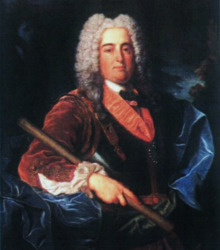
were admitted into the Order of Christ on 7 April 1696. Later that year, the king finally decided to confer on João the titles of the heir apparent, namely Prince of Brazil and Duke of Bragança. On 1 December 1696, on the anniversary of the Portuguese Restoration War of 1640, a grand ceremony was held in which João was invested with his titles. The ceremony involved the placing of a large ermine and red velvet mantle on his shoulders, as well as the adornment of his person with various jewels and royal regalia.
Just over a month before João's tenth birthday in 1699, his mother Queen Maria Sofia died at the age of 33. This caused João to retreat from court and become depressed for many months. Catarina of Bragança, his aunt and the former Queen consort of England, Scotland, and Ireland, then took control of his education. She resided in the palace she had built, Bemposta Palace,

and remained João's main tutor and female role model until her death in 1705.
In April 1700, João fell terribly ill; it was assumed that he was on his death bed. Fearing his imminent demise, he asked for his last rites and confessed his sins. To everyone's surprise, he rallied and soon returned to his normal activities, his complete recovery being considered a miracle by the court.
The death of João's sister Teresa Maria in February 1704, greatly saddened him. It caused him to avoid appearing at court for some months and to estrange himself from his father, who favoured João's younger brother, Manuel, Count of Ourém.

During this time, much gossip was spread and worries arose about whether João would ever recover from his depression. In May of that year, he eventually returned to the court and reconciled with the king, saying that his saudades for his sister would not get in the way of his performing his duty to the king.

In early December 1706, Pedro II moved himself to the Royal Quinta in Alcântara, as he was growing ill and needed space from the court. On the fifth of that month, the king caught a high fever, and the court doctors met to examine him fully. They determined his health was greatly deteriorating. The next day, Pedro II called all of his children to his bedside and told them of his coming demise. He appointed João as prince regent of the kingdom and asked that all of his children follow João's wishes. Although he appointed João the prince regent, Pedro II still favoured his youngest son Manuel, and the king gave Manuel a special gift that no other child received.
King Pedro II died in his sleep on 9 December 1706. Following his death, Ribeira Palace was redecorated as a reflection of the mourning. On the façade towards the Terreiro do Paço,

large black banners were hung from the windows for this purpose. A month later, the time was declared to be appropriate for João to be acclaimed king. Preparations for João's acclamation had already been started and once allowed, the royal palace was redecorated; the black banners were replaced with red ones, and fruit wreaths were hung throughout all of the palace.
On the day of João's acclamation, 1 January 1707,
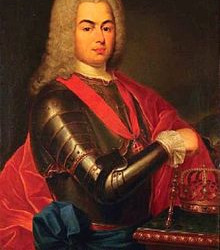
his new throne was placed on the balcony of the Torre do Rei (Tower of the King) of Ribeira Palace. Specially-made tapestries illustrating the allegories of Justice and Prudence were hung high above the Terreiro do Paço to remind the public that these were the traits their king would have. Once João sat down on his throne, wreaths made of gold were laid around the throne and balcony. Wearing his Cross of the Order of Christ,

and with the Portuguese Crown Jewels

beside him, and not on him, as was the Portuguese royal custom, João was acclaimed "His Majesty, by the Grace of God, King of Portugal and the Algarves, before and beyond the sea in Africa, Lord of Guinea and of Conquest, Navigation, and Commerce of Ethiopia, Arabia, Persia, and India, our Lord, John, the fifth of that name in the table of the Kings of Portugal."
João was now king of an empire that stretched four continents. He was also the head of state of a kingdom that was at war with Spain and France. His first regnal act was to renew Portugal's membership in the League of Augsburg and continue in the war alongside the England and the Habsburgs. Portugal quickly supplied more troops to aid her allies in the war. This new level of Portuguese involvement allowed João's general, António Luís de Sousa, Marquis of Minas, to capture Madrid on 28 June 1706. While Portugal put vast resources into the war, contrary to João's predecessors, who avoided conflicts in Europe, activity in the war soon lost the interest of the king, who had more pressing affairs to attend to.
During his life, Pedro II had worked a long time to secure João a marriage with an Austrian archduchess in order to guarantee Portugal's alliance with the Habsburgs. João continued these negotiations and finally succeeded in negotiating a deal. On 27 June 1707, Fernão Teles da Silva, Count of Vilar Maior, signed a marriage contract with Holy Emperor Joseph I
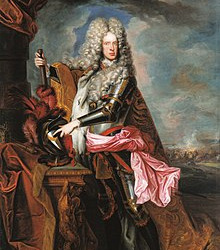
that made official a match between João and the emperor's sister, the Archduchess Maria Anna of Austria. The contract also set the archduchess's dowry at 100,000 crowns, a vast sum for the day.
The armada that Portugal sent to escort Maria Anna from the Lower Countries to Lisbon arrived in the Tagus river estuary on 26 October 1708.

The flagship, in which Maria Anna traveled, berthed at the docks of the private garden of Ribeira Palace, where João and a party of the kingdom's richest and most powerful nobles met the new queen for the first time. The marriage celebrations lasted until 27 December; they were sumptuous and very costly.
By late 1710, João and Maria Anna had not produced an heir to the throne. It had been two years since the couple had been married, and the court was starting to question the future of the House of Bragança. In early 1711, the king met with Franciscan Cardinal Nuno da Cunha e Ataíde, High Inquisitor of the Portuguese Inquisition, who told him that if he promised God to build a Franciscan convent in Mafra, God would deliver his long desired heir. Accordingly, João promised that if Maria Anna became pregnant before the end of 1711, he would build a Franciscan convent in Mafra. João's wish would come true later that year, when Maria Anna fulfilled her duty as queen and gave birth to the Infanta Maria Barbara of Bragança on 4 December 1711.
João and Maria Anna had a successful marriage, but lived largely separate lives. Maria Anna devoted herself to preserving the decorum of the royal court and her own religious interests, while João concerned himself with whatever pleased him at the moment. João kept many mistresses throughout his royal career, including Filipa de Noronha, Paula de Odivelas,

Luísa Inês Antónia Machado Monteiro, Madalena Máxima de Miranda, Inácia Rosa de Távora, and Luísa Clara de Portugal.

Maria Barbara's birth was followed by the birth of Pedro, Prince of Brazil, on 19 October 1712, which temporarily gave João a male heir.

Prince Pedro's death on 29 October 1714 greatly saddened him, but he took solace in the fact that his son, the Infante José (now Prince José), had been born on June 6 earlier that same year. Following the birth of Prince José, João and Maria Anna would have three more children: Infante Carlos, born 2 May 1716, Infante Pedro, born 5 July 1717, and Infante Alexandre, born 24 September 1723. Of the last three infantes, only two would survive to adulthood, Infante Carlos and Infante Pedro; only one would continue the Bragança line: Infante Pedro.
João's children were trained rigorously growing up. His plan was to have an intelligent son who could take his place as king, a strategically married daughter, and well-prepared statesmen sons; but he would achieve only part of his goal. From her birth, Infanta Maria Barbara's marriage had been closely arranged and monitored by João. When the engagement of Mariana Victoria of Spain

to Louis XV of France

was nullified, João proposed Infanta Maria Barbara as a possible bride for Louis XV, but in the end she was refused. João still managed to gain something from the dissolution of the engagement between Louis XV and Mariana Victoria, i.e., a wife for his son Prince José and a husband for Infanta Maria Barbara, Mariana Victoria's older brother Fernando, Prince of Asturias.
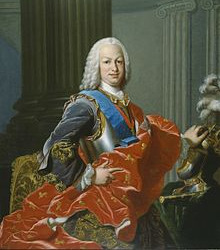
Negotiations between Portugal and Spain began in 1725, and four years later João's eldest children would be matched with their spouses-to-be. The princesses Maria Barbara and Mariana Victoria were exchanged at a ceremony, called the Exchange of the Princesses (Troca das Princesas), held on the Caia River on 19 January 1729. Prince José married Mariana Victoria on 19 January 1729 in Elvas, and Infanta Maria Barbara married Prince Fernando on 20 January 1729 in Badajoz.
None of João's three other sons would marry in his lifetime. Infante Alexandre died at the age of five, and Infante Carlos died at the age of twenty without any marriage proposals or children. Only Infante Pedro would live long enough to marry, but João did not live long enough to see it. Infante Pedro married the daughter of his older brother King José I, Princess Maria Francisca, Princess of Brazil, on 6 June 1760. When Princess Maria became Queen Maria I of Portugal upon the death of her father, King José I (João's son), Prince Pedro became King Pedro III, following Portuguese royal law that if the consort of a queen regnant produced children with the queen regnant, he would become king of Portugal jure uxoris.
João fathered at least four children from various extramarital affairs: António of Braganza, by Luísa Inês Antónia Machado Monteiro, Gaspar of Braganza, Archbishop of Braga, by Madalena Máxima de Miranda, José of Braganza, High Inquisitor of Portugal, by Paula de Odivelas, and Maria Rita of Braganza, by Luísa Clara de Portugal. Out of his four illegitimate children, the three males were all recognized as João's sons and were collectively known as the Children of Palhavã, after the Palace of Palhavã that belonged to Luís Carlos Inácio Xavier de Meneses, 1st Marquis of Louriçal,

where they lived at João's expense. The Children of Palhavã received educations worthy of nobility and went on to become noteworthy members of the clergy. Maria Rita was never officially recognized as his daughter, but he informally arranged for her life at the Convent of Santos and managed her expenses. The husband of Maria Rita's mother, Jorge de Meneses, attempted to stop João's actions for Maria Rita, but the king had him exiled to Spain and then to England.
Regnal politics
When João became king, he chose to reign as an absolute monarch. Notably, he never convened the Portuguese Cortes, the ancient parliament of the three estates in Portugal, and actively ignored meetings of the Council of State. However, João did not act by himself when making decisions; rather, he frequently consulted a close circle of well-informed advisers and held weekly intimate audiences with members of all three estates, which he preferred to larger institutions, such as the Cortes and the Council of State, which he viewed as incompetent and bloated. The Count of Povolide remarked on John's governance style, stating that "he established a predominance of personal consultation over institutional consultation."

The highest position in the king's government was that of Secretary of State of Portugal, the equivalent of a modern-day prime minister. This position was always filled by a favourite of João, the most notable one Diogo de Mendonça Corte-Real,
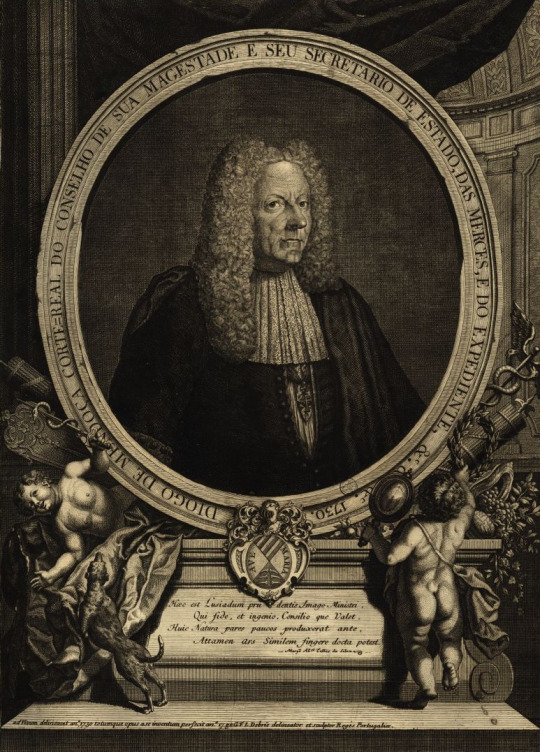
whom the king consulted with on every matter, to such a degree that it often appeared that he was the king's only minister. When João became king, he inherited a powerful and large Council of State made up of numerous bishops, nobles, and bureaucrats, which was charged with being the utmost consultory body to the king, as it was during the reign of João's father. However, João's dislike of institutions and consultative bodies led him to cease convening the council formally, leading the prominent politician and diplomat Luís da Cunha to refer to the king as a despot and his government as absolutist.
Although the Council of State was never convened, several of its members were nonetheless close advisers to the king. Alongside Diogo de Mendonça Corte-Real, Cardinal João da Mota e Silva and High-Inquisitor Nuno da Cunha e Ataíde were close advisers to the king, the former eventually substituting Mendonça Corte-Real as Secretary of State when he died in 1736. Though he disbanded most institutions, João notably maintained the Junta of the Three Estates, a governing junta created by João's grandfather, King João IV, which managed the finances and maintenance of military installations, troop raising, and taxation related to defense. Having engaged in multiple conflicts throughout his reign, both in Europe and his empire, João understood the necessity of the junta and carefully picked its members, only selecting those deemed the most knowledgeable and competent. Similarly, João maintained the Council of the Treasury, which managed the finances of Portugal and its empire, including tax collection and budget accounting for the majority of Portugal's organizations (except the military), and exerted authority over the Casa da Índia, the Royal Mint, and the custom houses across Portuguese territory.
When João ascended the throne, he found himself entangled in the War of the Spanish Succession, as King Pedro II had signed the Methuen Treaty in 1703, which aligned Portugal to the Grand Alliance against the House of Bourbon and allowed Grand Alliance forces to launch their invasion of Spain from Portugal. Only months after assuming the throne, John saw his forces overwhelmingly defeated in at the Battle of Almansa, a defeat that jeopardized Portuguese forces in Spain and the outcome of the war. Portuguese forces continued to fight alongside the Grand Alliance until agreeing to an armistice with Spain and France on 8 November 1712. The war finally came to an end in 1713 with the signing of the Treaty of Utrecht, whereby Portugal regained possession of territories conquered by the Bourbon coalition and acquired new territories in South America.
With the War of the Spanish Succession ended, João could re-establish relations with the courts of Europe. His first grand act of diplomacy was the dispatch of Luís Manuel da Câmara, 3rd Count of Ribeira Grande, as his ambassador to the court of Louis XIV of France, in early August 1715. The grandson of François, Prince of Soubise, and cousin of Hercule Mériadec, Prince of Guéméné, Câmara was personally chosen by João to foster amicable relations with the French court. No expense was spared on the count's triumphal entry into Paris, which cost 100 Louis d'or and received such great applause from the people of Paris that Alexandre de Gusmão, the count's secretary, stated that "the Count of Ribeira Grande has eternalized the grandness of our generous king." Although King Louis would die only weeks after the Portuguese embassy's arrival to France, the richness and extravagance of its entry to Paris was noted at the French court and across Europe and gained a new level of prestige for João and his kingdom.

As João concerned himself with the presentation of Portugal at the court of Europe from home through the planning and organization of important embassies, the king's brother, Infante Manuel, Count of Ourém, was similarly raising the name of Portugal throughout Europe. Having left the country in 1715 without the king's permission (as was required for royalty and high nobility), the Count of Ourém traveled throughout Europe, staying with Portuguese ambassadors and nobles across the continent, causing quite a fanfare. Although the king was displeased that Manuel left without permission, the king forgave the infante, writing to Manuel "your age absolves your mistake". Now having the king's permission, Infante Manuel entered the service of Prince Eugene of Savoy,

serving alongside him at the successful Battle of Petrovaradin. Over the next 17 years, the Count of Ourém moved from court to court as a celebrity and military hero and was even considered as a candidate as King of Poland by provision of the 1732 Treaty of the Three Black Eagles. Manuel's adventures throughout the continent inspired several literary works and gained him celebrity, raising Portugal's prestige in the eyes of Europe.
João's reign was characterized by a stressed importance of relations with Rome and the Papacy, though the state of relations with the Holy See largely depended on the Pope at the time. João sought acknowledgement by the pope as a lawful and righteous monarch as a means of international recognition of his capabilities and authority. Relations with João's first pope, Clement XI,

were largely successful, resulting from mutual beneficial agreements. In 1716, in response to a request by Pope Clement XI to João for aid in the fight against the Turks, the king sent an armada of Portuguese ships to assist Venice and Austria in their conflicts with the Turks that was led by his brother, Infante Francisco, Duke of Beja, and Lopo Furtado de Mendonça, Count of Rio Grande. In the same year, João ordered a formal, triumphal entry for his ambassador in Rome, Rodrigo Anes de Sá Almeida e Meneses, Marquis of Fontes. Seeking to mimic the response received at the French court, 5,000 cruzados were spent on a luxurious entry for the Portuguese envoy. The ceremonial procession included a convoy of 300 carriages surrounding the pièce de résistance of the procession, the Oceans Coach,


an ornate carriage made in Lisbon to demonstrate the wealth of the Portuguese empire to Rome. Having impressed the papal court, Pope Clement XI raised the dignity of the Archdiocese of Lisbon to the Patriarchate of Lisbon, making the Portuguese capital only one of two dioceses with this title in Europe, alongside Venice. João's good fortune with the papacy and Italy would continue to raise the next year, in 1717, when the aid of a Portuguese squadron of ships helped win the Battle of Matapan, in the ongoing Ottoman-Venetian War.
Pope Clement XI's successor, Pope Innocent XIII,

had served as Apostolic Nuncio to Portugal from 1697 to 1710, at the court of João and his father King Pedro II. However, Innocent XIII's time in Portugal is cited to have been the source of his dislike of the Society of Jesus, owing to the immense power that the Jesuits held at the Portuguese court and the concessions they held across the Portuguese Empire at the time. An ongoing issue of importance to the Portugal was the long-standing Chinese Rites controversy, which largely concerned the methods used in Asia by the Jesuits, which were largely under patronage of the Portuguese. Innocent XIII's decision to prohibit the Jesuits from continuing their missions in China caused great upset at the Portuguese court. Though Innocent XIII's successor, Pope Benedict XIII,
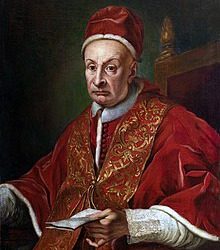
was the only Pope to descend from Portuguese royalty (descending from King Dinis I of Portugal),

relations were no warmer with Portugal than under his predecessor. Discontent with the Vatican's dismissal of his requests, João retaliated against Benedict XIII in 1728, closing the Papal Nunciature in Lisbon, recalling all Portuguese cardinals from Rome, and prohibiting official relations between Portuguese subjects and the Holy See. Though Benedict XIII sought to resolve the issues through an amicable intermediary, King Philip V of Spain,

though João refused.
An issue of significance to João concerned the rank and appointment of the Apostolic Nuncio in Portugal, which the king wished to be raised to the dignity of a crown-cardinal and demanded input in the selection process. Both Clement XI and Innocent XIII had denied João's requests and Benedict XIII had failed to mediate a resolution. Only during the fourth papacy of João's reign was the issue resolved, when Pope Clement XII

acquiesced to the king's demands, in 1730, elevating the Portuguese nunciature to the dignity shared only with France, Austria, and Spain. João's last pope and Clement XII's successor, Pope Benedict XIV,

had a markedly better relation with the king, granting the king his desired recognition as a lawful Christian monarch. In 1748, the pope awarded the title of Most Faithful Majesty to João and his successors.
João's reign saw the rise of the Americas as the bastion of Portuguese imperial power, as fortunes became less lucrative in Asia and Africa. Under João, the Portuguese Empire saw territorial gains in modern-day Brazil, India, Kenya, Uruguay, East Timor, Angola, and Mozambique, among others.
Portuguese America occupied the highest priority in João's administration of the Portuguese Empire. The American colonies of Brazil and Maranhão had become vital sources of wealth to the royal treasury, making the protection, expansion, and good governance of Portuguese America crucial to imperial policy in the Joanine era. Expansion of Portuguese territory in the Americas was also a concern, which was primarily achieved through military incursions into the interior of the continent by Bandeirantes. Portugal also regained control of Uruguay following the Treaty of Utrecht, in 1714, and successfully defended it against an attempted Spanish reconquest in the Spanish–Portuguese War of 1735–37.
In the 1690′s, during the final years of King Pedro II's reign, precious resources were discovered in Brazil, namely vast gold and diamond deposits. However, exploitation of the resources primarily began in João's reign, with the establishment of mining companies, taxation systems, and a mercantilist supply chain, which ushered in a period known as the Brazilian Gold Rush. The Royal fifth was instituted as a form of taxation on mining activities, requiring a fifth of all gold to go directly to the king's treasury. In an effort to consolidate royal authority while promoting efficient governance, João took control of the Captaincy of São Vicente (in 1709) and the Captaincy of Pernambuco (in 1716), establishing direct royal governance in the two most valuable provinces of Brazil. In 1721, João ordered the separation of the region of intense mining from the rest of the Captaincy of São Vicente, into the autonomous captaincy of Minas Gerais (General Mines), allowing for the colonial administration to collect taxation more effectively.
Asia had been the traditional base of the Portuguese Empire's wealth and power, but its declining returns became especially noticeable during João's reign as gold and diamonds from the Americas flowed to Lisbon. Portuguese India, historically the "crown jewel" of the empire, was economically constrained, especially under the restrictive rule of the Portuguese Inquisition in Goa, which prohibited commerce with non-Christian merchants. Concurrently, Portugal's most important ally in the Indian subcontinent was the Mughal Empire, entered into a drastic decline following 1707, coinciding with the rise of the Maratha Empire, long-time enemies of the Portuguese. Portugal suffered territorial losses after the Battle of Vasai and the Maratha conquest of Baçaim, although the size of Portuguese India would triple from 1713 to 1788, in an era known as the Novas Conquistas (New Conquests). The declining importance of Portuguese India resulted in numerous administrative reorganizations during João's reign, including the independence of Portuguese Mozambique from rule by the Viceroy of Portuguese India, as well as the creation of a direct commercial route from Portugal to Portuguese Macau (present day China) which eliminated the stop at the Indian port of Goa.
The Portuguese colonization of Africa was less important to João's colonial priorities compared to the Americas and Asia. Minor contentions with Dutch corsairs blocking shipments to and from the Portuguese Gold Coast in the 1720′s resulted in successful Portuguese victory over the Dutch in minor naval battles. Notable, tensions were also raised with Britain in 1722 when British forces established a fortification in Cabinda (in modern-day Angola), which had been claimed and evangelized by the Portuguese since the 15th century. A notable rare exception to the long-standing Anglo-Portuguese Alliance, João ordered galleons from the Armada do Brasil to dispatch to Cabinda to either take possession of the fort or destroy it and its men, resulting in a Portuguese victory in 1723. Portugal briefly reconquered Mombasa (modern-day Kenya) in 1728, only to lose control over it again in 1729, ending the last period of Portuguese rule in Mombasa.
Joanine culture
João is often remembered as one of the greatest patrons of the arts in Portuguese history, having commissioned numerous construction projects and artistic studies. The king's most famous and important work was the Royal Palace-Convent of Mafra.

In early 1711, married to Maria Anna of Austria for three years and without an heir, João grew worried for the future of the House of Bragança. He met with D. Nuno da Cunha e Ataíde, High-Inquisitor of Portugal, who assured the king that if he promised to build a convent for Franciscans in Mafra, in the Lisbon countryside, Maria Anna would bear him a child by the end of 1711. João agreed to do so. Construction started in 1717, with plans for a modest church convent for one hundred friars. However, in the following years, with a gratuitous flow of gold from the American colonies of Brazil and Maranhão, the plans were altered to become a magnum opus of João's reign, accommodating three hundred friars and adjusted to become a hybrid convent-palace, including a royal library, a basilica, and a vast set of apartments for the royal family. Noting the vast size and scope of the project, Charles de Merveilleux, a Swiss nobleman living in Portugal in 1726, remarked that "King João has decided to build a second Escorial."
With the new plans for a palatial complex, the project at Mafra, entrusted to royal architect João Frederico Ludovice,

became much more than a fulfillment of a religious promise, but rather a demonstration of monarchical power and wealth. By 1729, 15,470 workers from throughout Portugal and its colonies were contributing to the construction of the palace, alongside a total of 6,124 infantrymen and cavalrymen, making a total of 21,594 persons involved in the building process and site that year. While the majority of the palace was completed by 1730, João was so consumed in completing the project that he decreed it mandatory for all inhabitants of the villages of Mafra and Ericeira to work at the palace, requiring an excused permission not to participate, and only under extraordinary circumstances. In regard to the exuberant cost of the palatial complex, Merveilleux remarked that "three quarters of the royal treasury and nearly all of the gold brought on the fleets from Brazil were here, at Mafra, turned into stone."
Mafra stood as a monument to regal power, even though it would become only a pleasure palace and never a seat of authority. João commissioned numerous operas, comedies, and serenades to be celebrated at the palace with great pomp, and its enormous property became the favoured hunting grounds of the royal family for centuries to come. The king also began to celebrate his birthday annually at Mafra, starting in 1732. João housed one of the largest and most sumptuous libraries in Europe within the palace,

with over 36,000 volumes dating from the 14th to the 18th centuries. A curiosity about this library is that it used bats to preserve the books from the moths. This library and the Coimbra Univeristy Library are the only libraries in the World to use this method of preservation of the its books. Works at Mafra would continue until 1755, when the devastation wreaked by the Great Lisbon earthquake required as many workers as possible to rebuild the city.
João was afflicted with dropsy which caused his death in 1750 at age 60. He rest in the Bragança Pantheon.

King João has the following children:
By Maria Ana of Austria (7 September 1683 – 14 August 1754; married by proxy on 27 June 1708)
Maria Barbara, Queen of Spain (4 December 1711 – 27 August 1758) Married Fernando VI, King of Spain. She had no children from this marriage.
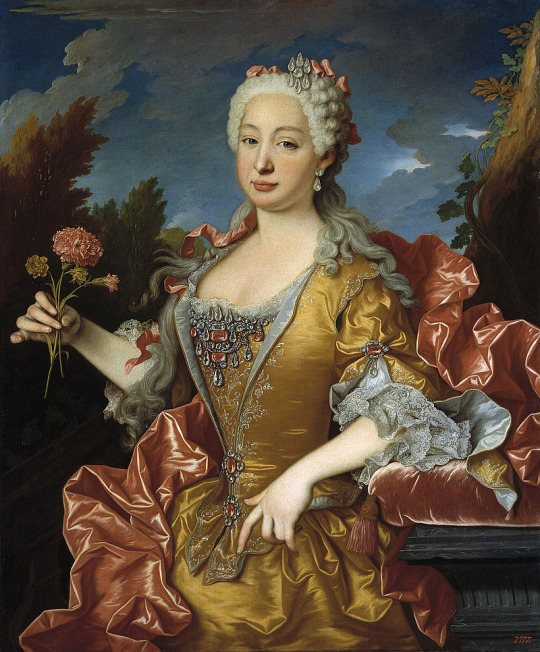
Pedro, Prince of Brazil (19 October 1712 – 29 October 1714) Prince of Brazil from birth to his death.

José I of Portugal (6 June 1714 – 24 February 1777) King of Portugal from 1750 until 1777. He was married to Mariana Victoria of Spain, daughter of King Philip V of Spain. He had four children from this marriage.
Infante Carlos of Portugal (2 May 1716 – 1 April 1736) He died at the age of 19, of a fever.
Pedro III of Portugal (5 July 1717 – 25 May 1786) King of Portugal, jure uxoris, from 1777 until 1786. He was married to Queen Maria I of Portugal. He had seven children from this marriage.
Infante Alexandre of Portugal (24 September 1723 – 2 August 1728) He died at the age of 4, of smallpox.
By Luísa Inês Antónia Machado Monteiro
António of Bragança (1 October 1714 – 14 August 1800) One of the three Children of Palhavã. João V recognized him and gave him share of his estate.
By Madalena Máxima de Miranda (c. 1690 – )
Gaspar of Bragança (8 October 1716 – 18 January 1789) Archbishop-Primate of Braga from 1758 until 1789. One of the three Children of Palhavã. João V recognized him and gave him share of his estate.

By Paula de Odivelas (1701 – 1768)
José of Bragança (8 September 1720 – 31 July 1801) High Inquisitor of the Portuguese Inquisition from 1758 until 1777. One of the three Children of Palhavã. João V recognized him and gave him share of his estate.
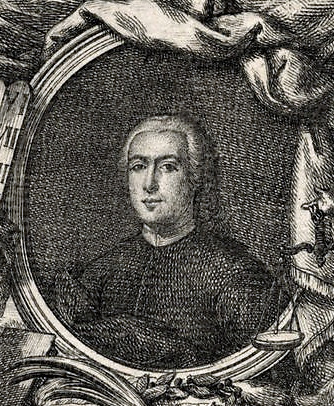
By Luísa Clara de Portugal (21 August 1702 – 31 August 1779)
Maria Rita of Bragança (28 May 1731–27 November 1808) Nun at the Convent of Santos, in Lisbon. João V did not officially recognize her, but he paid for her expenses.
14 notes
·
View notes
Text
Immigrants in America: Misunderstanding, Discrimination and Roots
In today's world immigration is a salient and important issue affecting millions of people world wide. In this essay we will discuss this issue and look at its relevance in today's United States. When looking at an issue with as large of a scope as immigration it is important to survey many different factors that make the issue relevant and important. In this essay we uncover and look at what makes immigration in the United States so complex and current. In the modern United States immigration is often at the center of many major media outlets and discussions. One of the most relevant issues in immigration pertaining to the United States is DACA.
DACA, also known as the Deferred Action for Childhood Arrivals program, grants the children of undocumented immigrants access to stay in the country as long as they are in school or have a job. It also grants access to people who enter the country of age 16 or under. DACA originated during the Obama administration and has been one of the most controversial subjects over the last several years. Under the Trump administration DACA has fallen under heavy scrutiny, but has recently been upheld by a federal judge (Scott Neuman, 2018). The biggest part of the most recent federal court win is that the ICE has to fully resume DACA operations and accept applications. They also have to continue accepting renewal forms.
Even with DACA in place, the current administration frames immigration as a threat to the economy and national security (Pierce, Sarah, and Andrew Selee, 2017) . President Trump has taken matters into his own hands by reducing the amount of immigrants entering America’s borders by prioritizing those with higher education status (Jacobs, 2017). Trump’s rhetoric and campaign to have a reduced immigration rate, admission, and expanded enforcement has created a new ripple effect. It has created ripples in america's overall conversation and attitude towards these immigrants and forthcoming deportation. “DACA beneficiaries are our friends and neighbors and a critical part of American communities. Unnecessarily destabilizing their lives will have a ripple effect across our society (Beth Werlin, American Immigration Council).”
The Trump administration has fully negated the DACA program and poses for a stricter travel ban. So far, a travel ban has been placed against eight countries, Venezuela, Chad, Syria , Yemen, Somalia, North Korea, Libya, and Chad, this is both shocking in our admission history and unprecedented since 1980. Before, with the Obama administration, having deported 90% of its undocumented immigrants were convicted for serious crimes; now, out of the 110,568 undocumented arrests about 31,888 had no criminal background under the Trump administration (Sarah Pierce and Andrew Selee, 2017).
Under this new strict rule, parents who bring their children over are legally allowed to be deported back. This causes major issues for children who were brought to America very young who are living in a country with limited protection spaces (Sarah Pierce and Andrew Selee, 2017).
While concerns are emerging for children who were protected by the DACA program, there are other salient issues regarding immigration in the decline of international students and the economy. Because there are less immigrants, there is a negative existing impact hurting America’s economy and society. Trump’s rhetoric promises heavier regulation of immigrants entering the border and advocates for stricter enforcement such as ICE (Immigration Customs Enforcement). Some companies that disobey cooperation with ICE are punished by the government. Specific states are forced to comply with ICE and are allowed to be questioned or further acted upon.
In addition to this growing urgency to comply with ICE, there is a growing need to act on Temporary Protected Status (TPS). This status qualifies for individuals who seek refuge in the US because their home countries are too dangerous due to natural disasters or conflict. The administration has limited the TPS to only immigrants from specific countries. Trump has already deemed several countries safe even when they are still unsafe. TPS is currently protecting 400,000 immigrants, this is a crucial status that grants individuals rights to work and education. Without this status, many are exposed to impending deportation. In the rise of undocumented immigrants in risk of deportation, many organizations are attempting to pass bills in the advancement of TPS.
Immigrant workers still hold many important roles and jobs in our society. Immigrants contribute in many ways and often they take jobs that no one else wants, jobs that are low paying (Hoban, 2017). Having immigration status limits the worker’s job options because they have limited experiences in for example: speaking English, technical skills, and involvement in the US (Enchautegui, 2015). This generalization that all immigrants are considered a “threat” does not account for the many ideas and jobs that they bring to the table. We must clean up these stains of ignorance of what the government sees in immigrants. They are facing more issues than we could ever stomach, so they come to America, seeking a new chance to live a different life, but many are weeded out from high paying jobs. While many argue that improving education and skill development to American workers is something that needs to be focused on and many more believe that the current administration is not delivering the bills that buttress these ideals. A reason for which may be that the way people who have immigrated to the US are thought of, treated and labelled, and have been throughout history.
The treatment of immigrants and refugees in the United States is definitely linked to the views of immigrants and refugees today in the world as a whole. But these views are nothing new. María L. Cruz-Torres (2017) argues that, “today’s immigration policies are not new but vestiges of old ones created to control the crossing of the U.S.-Mexican border, and categories such as ‘illegal,’ ‘alien,’ ‘undocumented,’ and ‘model minorities’ are intrinsically linked to them”. Epithets like these have existed for ages, and reasons for this can be found in the history of immigration itself.
Immigration, specifically of Mexican immigrants, went unrestricted for much longer than European or Asian immigration, mostly due to economic reasons. This caused an increase in demand for Mexican workers after World War I, when United States “native” citizens were leaving job openings for the immigrant citizens, and of these immigrants a majority were Mexican. Mexican immigrants were accused of stealing jobs, as they are now.
The quantity of people immigrating has fluctuated with time but in recent times we are struck with very familiar statistics.“By 2015, immigrants made up 13.5 percent of the US population — a proportion not seen since 1920” (Young, 2017). Immigration has once again become extremely relevant in the United States, as shown in these statistics. The demographic has changed as well, immigration still occurs from Mexico and South America, but now we see a rise in immigration from Muslim countries. Thus beginning the demonization of Muslim immigrants.
Today, we link Muslim immigration with terrorism and violence, as shown in Julia Youngs words, “anti-Muslim nativism has spiked in the years since September 11, 2001, since then Muslims have become inextricably linked to the threat of terrorism in the American public sphere” (Young, 2017). Not only this but because of their “Muslim identities” they are considered to be different to get by or assimilate to American life. The same was said about many Asian immigrants, and when the United States encountered a period of anti-Semitism. People seem to be unable to differentiate between radical Muslim terrorists and terrorist groups versus peaceful Muslim-American citizens. Now, we know this prejudice exists and we know the roots and affects, what we don’t know is how it is currently being dealt with.
There are many organizations who are making an effort to integrate these misjudged immigrants by creating change in both local communities and in the federal courts. One of the many non-profit organizations fighting for pro-immigration is the American Immigration Council. This organization plays a key role in educating the public of the importance of immigrants and pressuring and targeting the government to pass laws that will benefit this group. The second organization that plays an imperative role in the breaking of the misjudgement about immigrants is United We Dream. Their role is that they are the largest youth-led organization composed of 100,000 members in America alone. This group inspires change and the powers that come from youth advocacy through leading the campaign, Here to Stay. The website used to boost this campaign sheds light on a myriad of stories shared by young immigrants, advocating and constantly challenging the public’s perception. The list continues from National Immigration Law Center to Florida Immigrant Coalition, these groups are all seeking ways to remedy this injustice and unify both allies and those in risk of deportation. Through an intersectional way of thinking, Families for Freedom fights for protection spaces and fights to keep families together from communities of color and advocating to make sure that all immigrants are guaranteed equal rights (Javangula, 2017).
In conclusion, immigration restrictions, rights, and resources remain a controversial problem in the United States. Whether it is revoking programs involving immigrant children or the general discrimination and generalization of entire communities or cultures, we still deal with problems involving immigrants and the treatment of “non-Native” citizens. We do not lack in immigrants, we lack in proper judgement of and resources for immigrants. It is obvious that we have not come very far in the past 100 years in the treatment and understanding of immigrants. Progress must be made to accommodate the rights of immigrant citizens in the United States. All United States residents deserve citizenship, no matter where they are born, or their parents were born, or their religion, or their native language. We must remember as a collective American consciousness that almost all of our ancestors were immigrants as well.
Bibliography:
Cruz-Torres, María L. “The U.S.-Mexican Border, Immigration, and Resistance.” Latin American Perspectives, no. xxx, 2017. Sage Journals, DOI:10.1177/0094582X17699908. Accessed 5 May 2018.
Enchautegui, Maria E. “Immigrant and Native Workers Compete for Different Low-Skilled Jobs.” Urban Institute, 14 Oct. 2015, www.urban.org/urban-wire/immigrant-and-native-workers-compete-different-low-skilled-jobs. Accessed 5 May 2018.
Hoban, Brennan. “Do Immigrants “Steal” Jobs from American Workers?” Brookings, 24 Aug. 2017. Brookings, www.brookings.edu/blog/brookings-now/2017/08/24/do-immigrants-steal-jobs-from-american-workers/. Accessed 5 May 2018.
Immigrants in the United States. 2017. American Immigration Council, www.americanimmigrationcouncil.org/research/immigrants-in-the-united-states. Accessed 5 May 2018.
Jacob, Ben. "Donald Trump proposes law to cut immigration numbers by half in 10
years." The Guardian [Washington, DC], 2 Aug. 2017, www.theguardian.com/
us-news/2017/aug/02/trump-immigration-law-reduction-10-years. Accessed 22
May 2018.
Javangula, Rohita. “7 Nonprofits Fighting for Immigration Rights.” EveryAction, 11 Sept. 2017, blog.everyaction.com/immigrant-rights-nonprofits. Accessed 5 May 2018.
Pierce, Sarah, and Andrew Selee. “Immigration under Trump: A Review of Policy Shifts in the Year since the Election.” Migration Policy Institute, 2017, www.migrationpolicy.org/sites/default/files/publications/TrumpatOne-final.pdf. Accessed 5 May 2018.
Taxes & Spending Power. New American Economy, 2017. New American Economy, www.newamericaneconomy.org/issues/taxes-&-spending-power/. Accessed 5 May 2018.
Young, Julia G. “Making America 1920 Again? Nativism and US Immigration, Past and Present.” Journal on Migration and Human Security, 2017, doi:10.14240. Accessed 5 May 2018.
0 notes